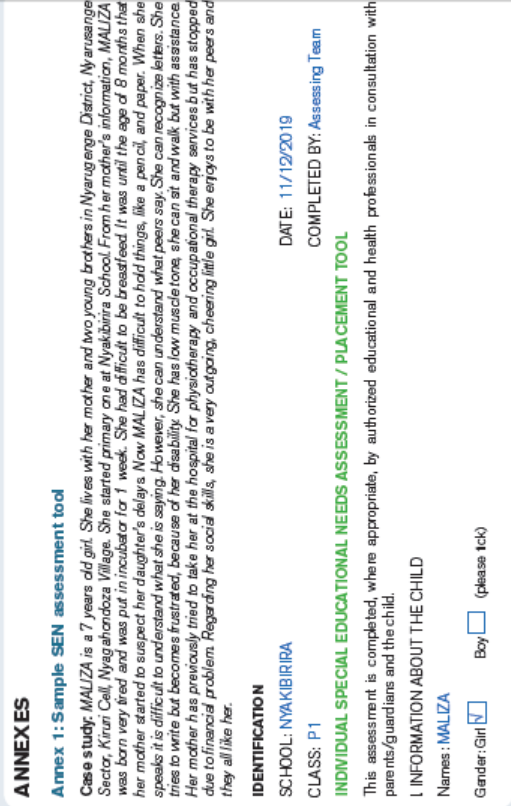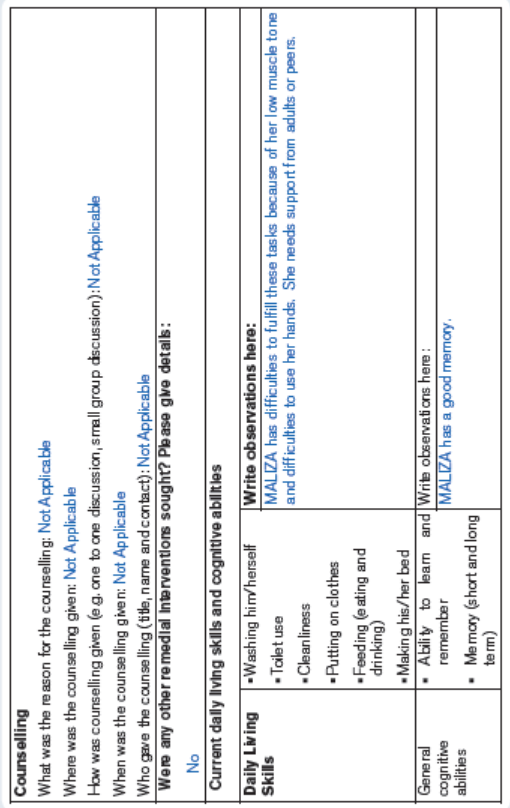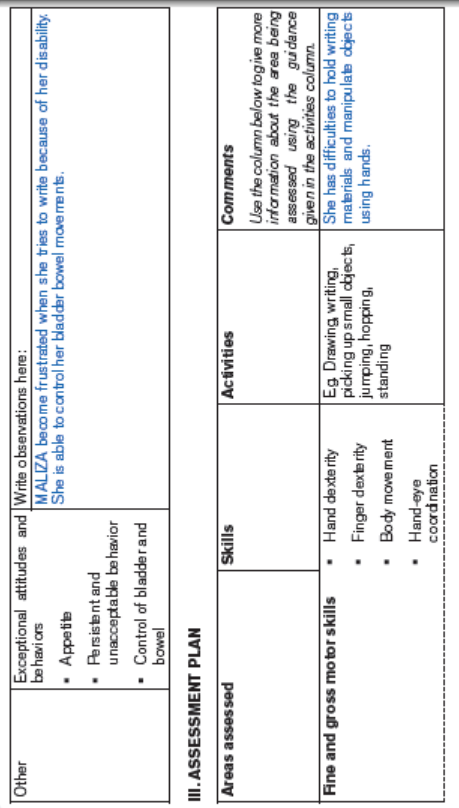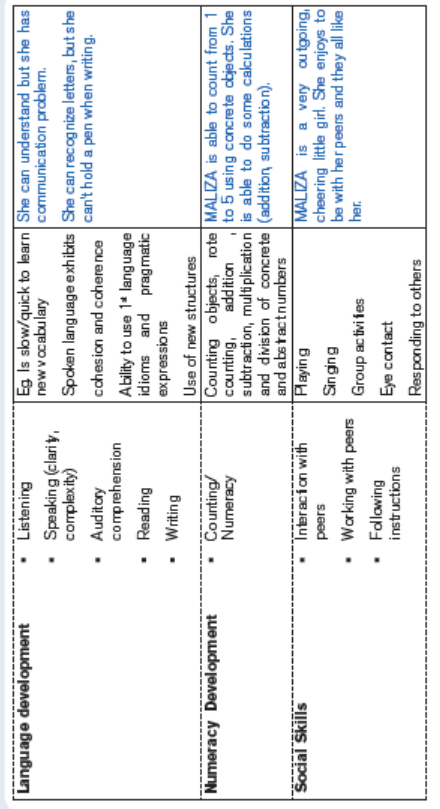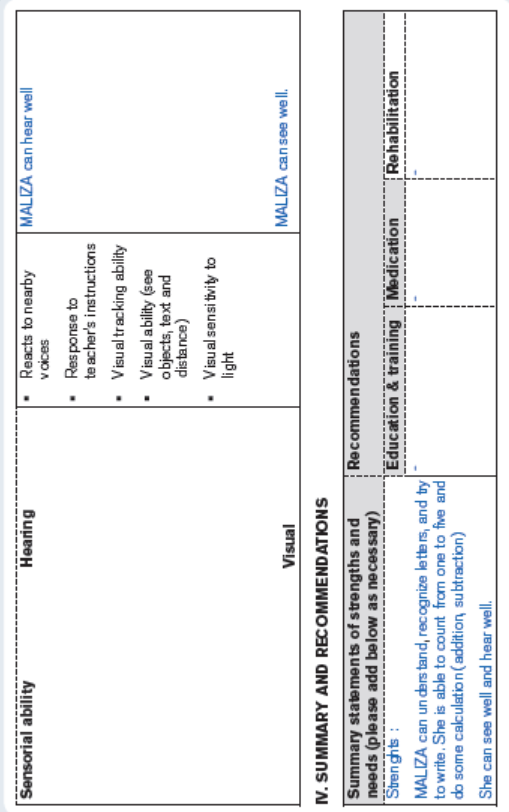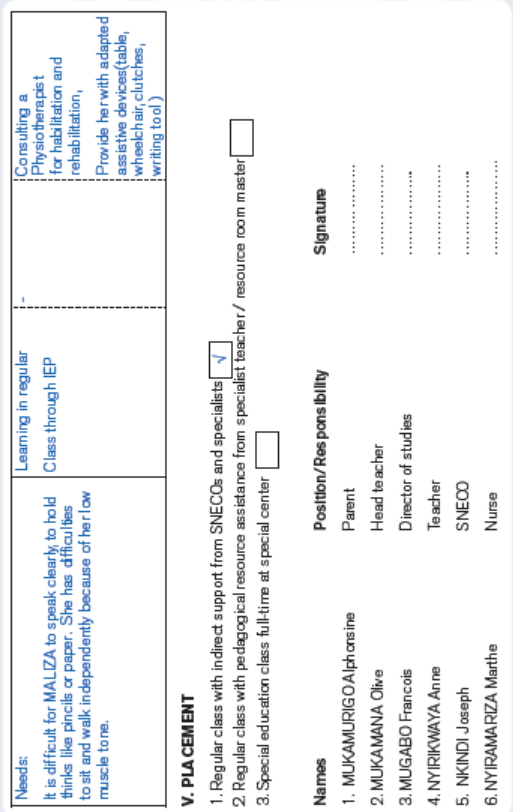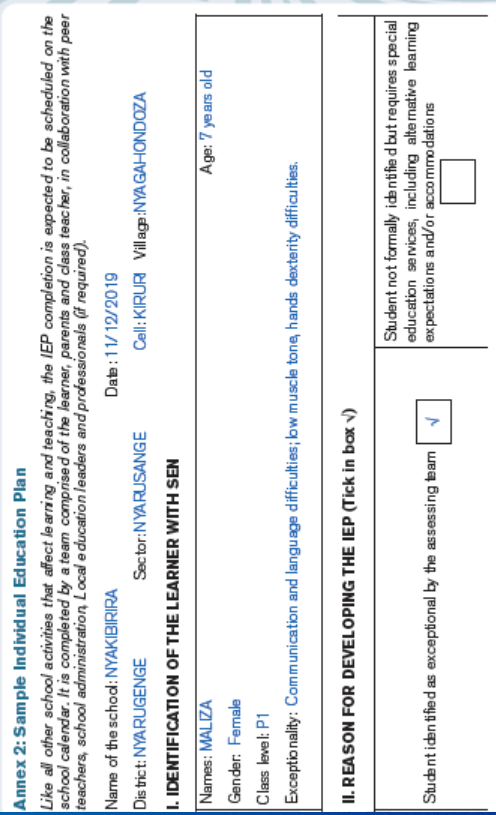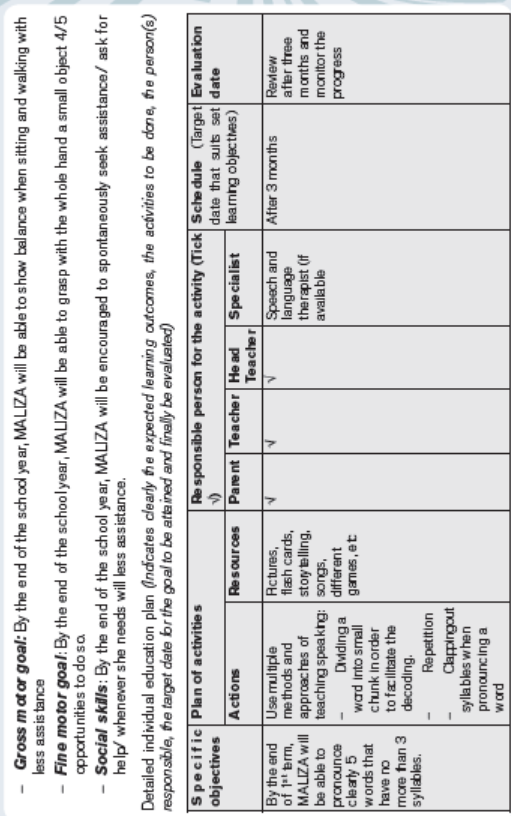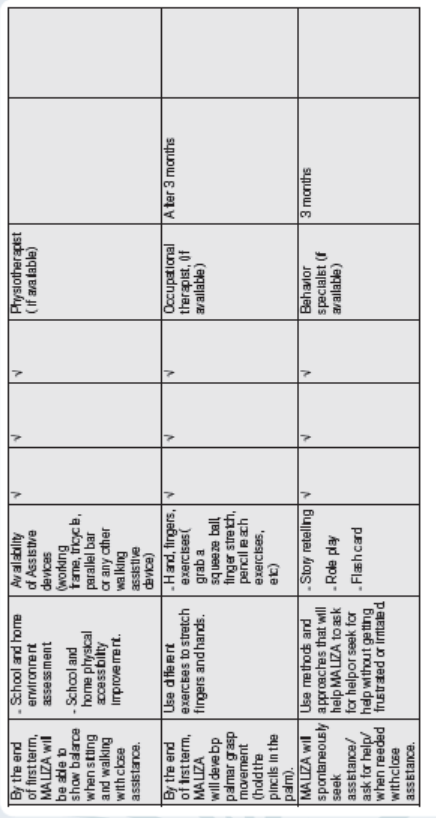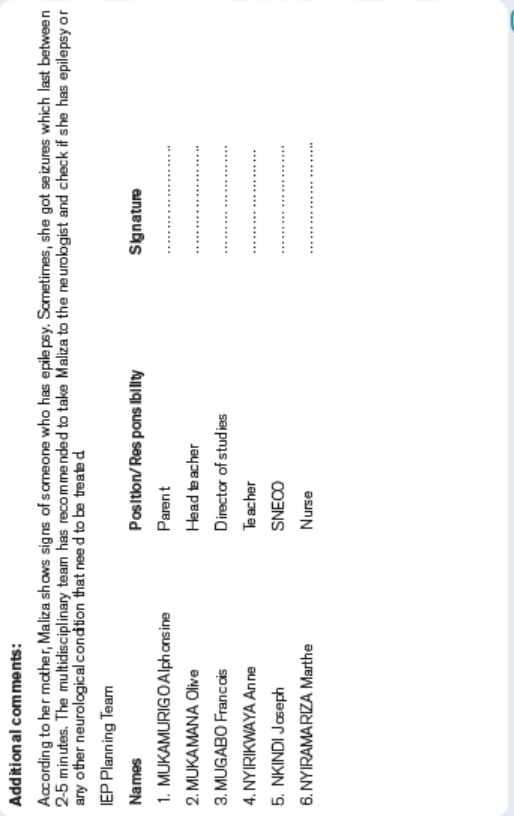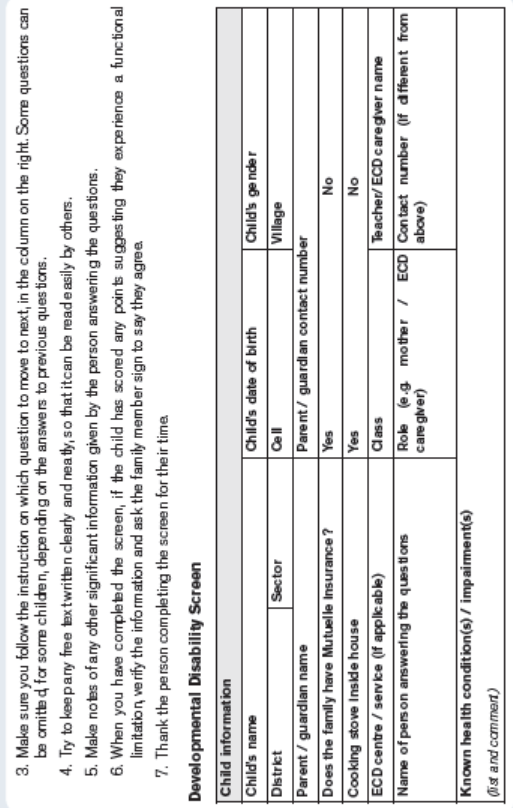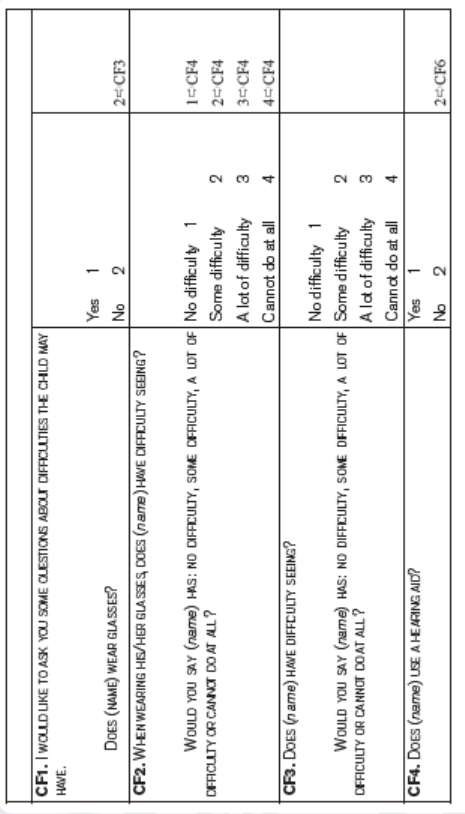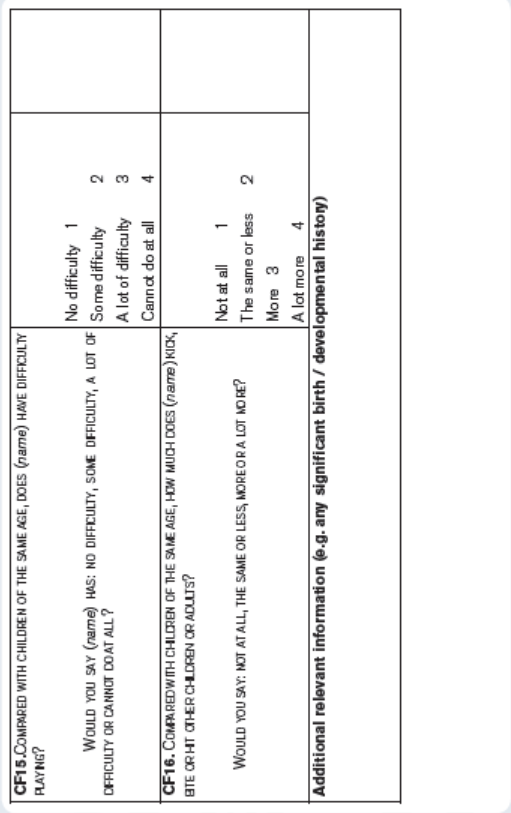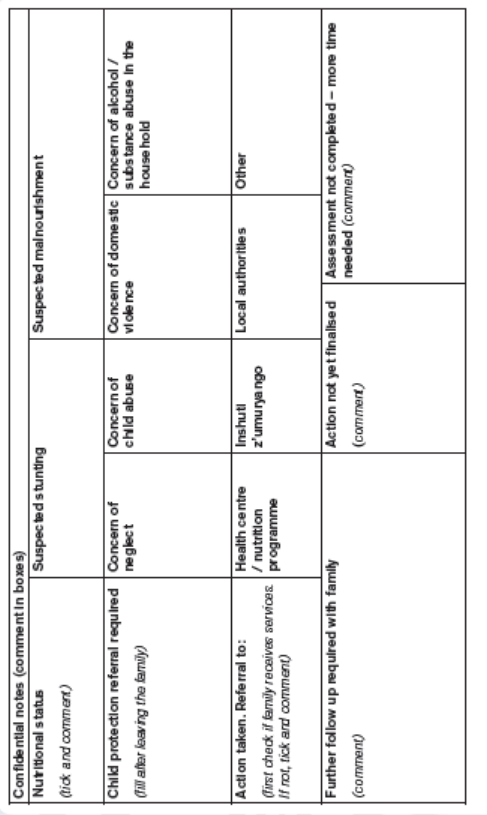Topic outline
UNIT 1: DELIVERY, MONITORING AND ASSESSMENT OF A LESSON IN 1 AN INCLUSIVE CLASS
Key Unit Competence:
Students should be able to competently deliver, monitor an inclusive lessonand conduct an inclusive assessment


1.1. Lesson delivery and monitoring in an inclusive class

1.1.1. Creating a conducive environment for learning
Creating a classroom environment which is conducive to learning is one of the
most important things a teacher can do. Education to be effective in schools, the
environment needs to be conducive to learning, allowing the learners space and
time to interact within the learning and teaching process. Creating and maintaining
stimulating learning environments can be achieved through effective classroom
organization, interactive and whole school displays and a climate of innovation.
The following are tips to make a classroom a conducive environment
for learning:
• Make sure learners with special needs occupy the front place near the
blackboard and close to the teacher or any other place of their preference.
This is very important for learners with sensorial difficulties and those with
learning difficulties.
• Try to arrange the classroom so that learners can move about freely,
especially if some children have visual or mobility problems. For example,
make sure that a child who uses a wheelchair or crutches can get in and
out of his/her desk easily.
• If you have the space, try to set aside an area of the classroom where you
can work with certain children individually or in small groups in order to
achieve peer learning.
• Sitting arrangement can help to promote cooperative learning during
teaching/ learning activities.
• Have a box that contains some story books or simple games that children
can use when they have completed their work ahead of others.
• Display pictures, posters, drawings and examples of learner’s work on the
walls. Make sure they are displayed at the learners’ eye level rather than
high up on the walls. You can also add different textures for touching to help
learners with visual problems.
• For some learning sessions, is better to go outside the classroom. For
example, lessons about plants and animals could be done in the school
compound.
• Remember that learners with hearing and visual problems will find lessons
outside the classroom more difficult to understand. Make sure such learners
sit very close to you.
• Bring in a mat to make a quiet reading corner.
• Whenever possible, use real objects to help the learners understand. Make
sure teachers allow the children to handle and touch these objects if they
are not harmful to them. This is very important for learners with seeing and
learning difficulties.
• Keep the classroom clean. Make sure all the learners, including those with
special educational needs, help to clean the classroom.
1.1.2. Teaching and learning materials display
a) Display of teaching and learning materials
A good teaching and learning may be worthless unless it is well displayed.
Many classrooms are not adequately furnished with facilities for display, but it
is important that they should have at least some display. The choice of display
methods is determined by the nature and the type of materials to be displayed.
The following methods can be applied:
• Tables or shelves placed or fixed to the sidewalls: These can serve both
purposes of display as well as storage.
• Display boards on the side wall: Soft board used for ceiling construction is
very good for this purpose because of the easy with which drawing pins can
be pushed in and out.
• Strips of finished timber on the side walls: These are very important for
hanging three dimensional materials (manipulable materials) with nails.
• Pegboards: A pegboard is a board with hundreds of identical holes which
can be used to secure visual aids, specimens as well as models. The holes
are used to fix whatever is to be displayed.
• Mobiles: A mobile is an arrangement of cards hang from the ceiling. The
cards can be used to display words, ideas or information that the teacher
wants the learners to remember. It is the best used where space on the
walls or tables is very limited.
Note: There is no standardized way recommended for display in your classroom
but as a teacher you should realize that a lot will depend on the availability
of space and type of resources to be displayed. In addition, the diversity of
learners needs and your own creativity are other important factors that should
guide you displaying educational resources.
b) Points to bear in mind when displaying teaching materials
The following are points that you should remember when displaying your materials:
• The resource or materials should be displayed properly so that all learners
are able to access, to touch, to see, observe and learn out of it.
• Avoid over displaying of educational resources. They should be removed
after one week or two depending on the class and type of learners.
• Some specimen, models or hardware resources may be dangerous for
pupils to handle on their own. Display such only when you use them with
the pupils and withdraw them for storage after the lesson.
1.1.3. Classroom monitoring: Monitoring the progress of learners
It is essential that a teacher walks around the class checking what the children
are doing when they are working on their own or in groups. If a teacher does
not monitor during a lesson, he/she will not know which learners are having
difficulties, thus he/she will not be able to help them. But if the teacher monitors
the progress of the learners during the lesson, he/she will be able to provide
individual help that responds to their need.
Provide individual help for learners with Special Educational Needs
Learners with special educational needs including those with disabilities and
others who are educationally vulnerable need more help and support than their
peers without disabilities. They will benefit more if the teaching is directed to their
particular needs. Individual help should focus on the skills and knowledge the
child needs to fully participate in the class.
Today’s classroom reflects the diversity of our communities and includes a mix
of students’ interests, needs, learning styles, and cultural backgrounds. This is
the reason, that the teachers should think on differentiating the curriculum by
focusing on the needs of students and provide strategies and approaches that
meet their needs.
a) Differentiation of the curriculum
Differentiated instruction refers to a wide range of instructional and classroom
strategies that teachers can use to help each student achieve the prescribed
learning outcomes. It is the component of classroom instruction that specifically
acknowledges and responds to learners’ diversity. Using differentiated
instruction establishes a supportive learning environment for all learners.
At the beginning of the school year, (just after some weeks after the school
years has started), the teacher should clearly establish the needs of the students
in the classroom. In almost every classroom there will be students who require
special attention and considerations. Remember, the teacher is not expected
to provide totally different programs to students; rather, the differences can be
managed using a variety of approaches and teaching methods. The teacher
should determine the best way and methods to address students’ needs. In an
inclusive setting, there may be:
• Students who can benefit from differentiated instruction but for those with
special needs the differentiation of curriculum is mandatory.
• Some students who require adaptations to instruction and assessment in
terms of lesson evaluation.
• Some students who require additional education supports to perform a
given task.
• Some students who require modifications outlined in their Individual
Education Plan.
• Some students who require individualized programming outlined in their
Individual Education Plan
In that way, the teacher should examine ways to meet the learning needs
within the unit or lesson being taught. A teacher who examines the needs of
a classroom in this way is able to see commonalties as well as differences in
students and be able to differentiate the curriculum.
The differentiated method helps both the teacher and the learners:
• For the teacher, it helps him/her to provide national curricula by
accommodating students with a wide range of abilities, interests, and
learning styles. Teachers can differentiate curriculum in three broad areas:
content, process, and product.
• For the learners, differentiated curriculum facilitates them in their learning
process, and at the end help them to succeed because varied instructional
approaches are used, thus matching their varied learning styles.
b) Strategies to differentiate the curriculum in the classroom
• Learning strategies
Learning strategies are instructional strategies that have been developed to
assist students with learning difficulties. Learning strategies include: teaching
study skills, editing assignments, reading strategies, and thinking strategies.
Two examples of learning strategies that can be used are: COPS strategy and
the JETS strategy.
COPS is an editing strategy that helps students edit their work by focusing on
four key elements of the editing process:
C: Capitalization
O: Overall Editing and Appearance
P: Punctuation
S: Spelling
JETS is a strategy for task completion or assistance in preparing to do an
assignment.
J: Job: What is it I have been asked to do?
E: Equipment: What will I need to do the job?
T: Time: How much time do I have to complete the job?
S: Satisfactory product: What do I have to do to complete my job in a
satisfactory manner?
• Graphic Organizers
Graphic organizers also known as mind maps, webs, clusters, think sheets
are visual diagrams that help learners understand and think by representing
abstract ideas and concepts in a concrete form.
• Lesson Frame
Lesson frames are used to present an overview of a lesson or concept. They are
presented in writing but may also include pictures or graphics, and are usually
placed on overheads, photocopies, chalkboards, or posters. They typically
indicate the course, topic, date, lesson outline, lesson outcomes, assignment,
and notes. Lesson frames help students to organize their thoughts around a
lesson.
The use of visuals (pictures or graphics) in lesson frames can help students
learn important routines or strategies. Visuals can be made using computer
programs, magazine cut outs, or photographs, and placed in student binders for
easy access. The student’s schedule may be represented by picture activities
scheduled for the day. Visuals may also be used during class presentations to
reinforce verbal and written information.
Scaffolding
Students who have behaviour problem, attention deficit or any other special
needs, may become frustrated when presented with a large assignment or
homework project. It is possible to avoid this frustration by using scaffolding
a strategy of providing clear structure and precisely stated expectations, and
breaking down tasks into manageable pieces.
Scaffolding Benefits
• Provides clear directions
• Clarifies purpose
• Keeps students on task
• Points students to worthy sources
• Reduces uncertainty, surprise, and disappointment
• Helps students to organize
• Breaks the work down into manageable pieces
• Provides a structure for completing the project
• Adaptation
Adaptations are planned, personalized alterations in the way teachers provide
instruction, in the way a student demonstrates learning, and in the assessment
of progress. Adaptations help students to achieve and to demonstrate the
achievement of the expected learning outcomes of the curriculum. Adaptations
are developed for individual students through planning by the teacher, student,
parents and possibly other support personnel. Students are assessed according
to the learning outcomes of the national curriculum. There are a variety of ways
that educators can provide adaptations for an individual student. These include
adaptations to:
• The physical and/or social environment
• Materials and resources, including the introduction of supportive equipment
• Presentations
• Testing and assessment procedures
• Assignments and homework
• Organizational supports
• The time required to achieve curriculum outcomes
Note: The list is not exhaustive. The strategies provided above are not the
only ones to be used when differentiating the curriculum. The teacher should
consider using any form of strategy depending to the needs of students in orderto support their need.

1.2. Conducting an inclusive assessment
a) Purpose of inclusive assessment
The overall purpose of inclusive assessment is the same as for any assessment
that caters for all learners including those with special education needs. The
primary purpose of assessment is to improve learners’ learning and teachers’
teaching as both learner and teacher respond to the information that it provides.
b) Principles of an inclusive assessments
Inclusive assessment involves the following:
• A range of methods and strategies that all aim to gather clear evidence
about learners’ achievements of learning outcomes for specific subjects;
• Methods that report on the outcomes of learning but also provides teachers
with information on how to develop and improve the process of learning for
an individual learner or groups of learners in the future.
c) Strategies for conducting an inclusive assessment
Assessment should give an indication of a learner’s level of achievement of the
learning outcomes associated with the course, topic or skill being assessed.
However, if a learner has a special educational need, then the assessment may
need to be modified so that the learners can demonstrate their learning.
The following are strategies to conduct an inclusive assessment:
Identify the learning outcomes (what you hope the learner will
know) being assessed
• What is the best way a learner can show the learning outcomes?
• Is there more than one way to demonstrate this knowledge/skill?
• Are you clear about which learning outcomes constitute a competence
standard? These must apply equally to all learners and may not be modified,
though the process by which the learner is enabled to demonstrate the
competence standard can be adapted.
Identify the criteria of assessment (in terms of lesson evaluation)
(how they can demonstrate knowledge, skills, attitudes) being
assessed
• How will you judge the level of achievement of each stage of the assessment
task?
• How will you distinguish exceptional performance from partial achievement
of the learning outcomes?
• How have you communicated the criteria to the learners?
Identify any part of the task which could pose specific difficulties
for learners
List what a learner will have to do to complete the assessment and try to
anticipate difficulties, considering learning styles as well as SEN.
• Does this task cater for learners with different learning styles as well as
different learning needs?
• Is there an alternative form of assessment which measures the learning
outcomes just as well?
• What reasonable adjustments could be made?
• If you feel one of your learners is likely to find the task difficult, discuss this
with the learner directly
Consider ways that you could adjust the task
How might you change the task itself to make it more inclusive and less
discriminatory for all learners?
• Special arrangements (e.g. extra time) or alternative assessments (e.g.
presentation instead of essay) for a few select learners only tend to reinforce
the deficit view of learners with special needs.
• An inclusive approach should offer a range of assessments to all learners:
i.e. different assessment of the same learning outcomes.
Can the adjustments be built into the curriculum rather than ‘tacked
on’?
Assessment should be built into the curriculum and should reflect an equality
approach to learners rather than trying to fit learners into existing assessments.
• Learners generally do not want to be singled out for special treatment.
• If an alternative assessment which assesses the learning outcomes isavailable, why can’t it be made available to all learners?



UNIT 2: GUIDANCE AND COUNSELLING SERVICES FOR LEARNERS WITH SPECIAL EDUCATIONAL NEEDS (SEN) AND DISABILITIES
Key Unit Competence:
Students should be able to competently offer career guidance and counsellingservices to learners with SEN and Disabilities
2.1. Definitions of Guidance and counselling and their
importance
a) Definitions of Guidance and counselling
The term “Guidance” is derived from the word “guide” which means to show
others the way to a place or to direct somebody’s behaviour. Guidance is a
personal help and advice about how to do something or about how to deal with
different problems. Educational guidance is a process of assisting individual
learner to reach optimum individual development by helping individual making
choices, as well as make adjustments in relation to schools, curriculum, courses
and school life which contribute to the all-round development. It promotes selfdirection
and self-growth.
Guidance helps individuals understand better their abilities, know their
interests, to develop their skills and relate them to life goals. It helps individuals
reach a state of mature self-guidance and direction as a desirable member
of the society. It helps individuals to understand, accept and utilize his or her
aptitudes, interests and attitudinal patterns in relation to his/ her aspirations.
In school and college setting, it is aimed at leading the learners to the achievement
of desired life goals. It equips them with knowledge and techniques that enable
them to identify and find ways of solving problems.
Counselling is the process by which a person who has issues is helped to
identify, explore and examine alternative courses of actions and their possible
consequences.
It is concerned with addressing and solving specific problems, making decisions,
coping with crisis, working through feeling and inner conflicts and improving a
person’s way of relation to others. The overall aim of counselling is to make life
more satisfying by helping the client solve their problems or meet their needs.
b) Importance and principles of Guidance and Counselling
Learners with Special Educational Needs and Disabilities need guidance and
counselling even more than their peers without disabilities because besides
the normal challenges of life, they experience other problems emanating from
their disability. Many learners with Disabilities are faced with rejection, negative
attitudes and social stigma from family, peers and the society. This may result
in negative feelings like loneliness, isolation, withdrawal and failure to adjust
and develop a positive self-concept. Guidance and counselling come in to help
learners with disabilities face these problems and become self-reliant and
independent
The Counselling provided by trained professionals can have a profound impact
on the lives of the beneficiaries first, and second to individuals, families and
communities. This service helps people navigate difficult life situations, such
as the death of a loved one, divorce, natural disasters, school stress and the
loss of a job, drug abuse and life discomfort. It provides the tools and insights
to manage mental health issues, such as anxiety and depression. It empowers
people to lead healthy and fulfilling lives.
General principle, Guidance and Counselling is based on the belief that human
beings are basically self-determining creatures. The human beings have an
innate desire for self-direction towards independence and autonomy. Thus,
people have the ability to a great extent to control and to fully be responsible
for their actions.
i) Specific principle of guidance
The guidance focus on the following principles:
1. Guidance is concerned with the systematic development of the individuals.
2. Guidance is not a counsellor’s decision or compulsory advice rather it the
client who makes the decisions of the action to take.
3. Guidance is continuous and sequential educational processes. It thus
should be provided throughout one’s life.
ii) Specific principles of counselling
The counselling focus on different principles including but not limited to:
1. Counselling help the client become more aware of self and realistically
accept his/her abilities and limitations.
2. It is always client-centered. This means that the needs of the client come
first. Counsellor should not bring in his/her personal needs or be overlyinvolved.
2.2. Approaches and qualities of school Guidance and
Counselling service
2.2.1. Approaches of school guidance and counselling
There are four main approaches that are used in school guidance and counselling:
• Psychoanalytic
• Behavioural
• Cognitive behavioural
• Client centred theory/person centered theory.
a) Psychoanalytic approach
Psychoanalytic theorists believe that behaviour is motived by unconscious,
subconscious and conscious feelings, thought and motives. Its goal is to reduce
over dependence on defence mechanism, take demands bringing unconscious
information, experiences to conscious and allowing one gain insight into his/
her behaviour. This approaches focus on the following points:
a) Structure of personality
b) Conscious and unconscious mind
c) Defence mechanism and stage of development
• Structure of personality
Personality refers to the unique pattern of psychological and physical processes
which control your behaviour and thought and make you distinctly you. In
psychoanalytic approach personality is the interplay between the ID, the Ego
and the Super ego.
The ID is the biological component of the structure of personality. It is irrational
and unconscious. It works on pleasure principle of avoidance pain and seeking
pleasure. ID seeks immediate gratification.
The Ego is the psychological component of human personality. It is in realistic
and conscious. It develops as growth takes place. Ego balances on the
excessive impulses of conscious of the Id and the Super Ego.
The Super ego is the judiciary component of human personality. It develops
as a child internalizes the dos and don’ts in the society. It comprises the societal
norms. It is a major player in the development of one self-concept, using Super
Ego the child develops operating principles, self-governing rules.
• Conscious and unconscious mind
Conscious is the act or process of being aware, particularly of one’s
surroundings, thought and bodily condition. It refers to being, alert and
understanding your immediate environment. Unconscious is used to refer to
process which are outside or blocked from our present mind.
Unconscious motivates the action of the manner in which a client will present
their situation, but as the counsellor you have to try to reach the underlying
issue. Many problems are as result of mental processes which are hidden to
the client. The hidden process include experiences, wishes and impulses which
were either denied or ignored sometimes back hence become repressed. If the
repressed information is brought to conscious, faced and explored the some of
the client’s issues will be accepted, owned and resolved.
• Psychosexual stages of development
It is a central element of the psychoanalytic sexual drive theory, from the birth
every human being possess an instinctual libido (sexual energy) that developsin five stages.
Those stages are:
– The oral (0-1 age): Children derive pleasure from oral activities, including
sucking and tasting. They like to put things in their mouth.
– The anal (2-3 age): Children begin potty training.
– The phallic (3-6 age): Boys are more attached to their mother, while girls
are more attached to their father
– The latent (6 age to puberty): Children spend more time and interact
mostly with same sex peers.
– The genital: Individuals are attracted to opposite sex peers
Psychosexual stages of development
Every stage is characterized by its erogenous zone that is the source of the
libidinal drive.
• Defence mechanisms
It is the process used in order to protect oneself against extreme discomfort,
tension, mental composure and self-esteem in face of what could be a painful
situation. As we learnt in the structure of personality, the ego is governed by
the principle of reality, while ID seeks for the immediate gratification. The
super ego keeps threatening punishment on the Id and Ego. This scenario
generates anxiety. Conflict arises from wishes and reality become a threat
that results to the need of defence.
Defence mechanisms are used by parents, persons with special needs and
disability, when they have not accepted their situation. They include repression,
denial, rationalization, projection, reaction formation, introjection, regression,
displacement and rationalization.
• Techniques of psychoanalytic approach
Therapeutic techniques in psychoanalytic theory include interpretation of
behaviour and free associations to create trust and in-depth disclosure. The
counsellor looks into the behaviour portrayed and tries to analyse what is
motivating it. The counsellor builds trust with the client so that in a friendship’s
past experience are shared.
b) Behavioural approaches
The behaviourist believe that behaviour can be learnt, unlearnt and re-learnt.
Behaviour can be good or bad. Therefore, a person has the potential of being
good or bad. They believe that behaviours can be modified, thus a person with
unacceptable behaviour can learn acceptable behaviour.
• Goal of behaviourist
It is to initiate and strengthen adaptive behaviours, weakening and maladaptive
behaviour and reducing unwanted fears and anxieties. Teacher in special
needs education assist leaners identify and work towards eliminating under
desirable behaviour such as hyperactivity, excessive talking, impassivity
among others.
• Techniques of behavioural approaches
A counsellor using behavioural approaches, works having the client
• Controlling preceding events of a behaviour
• Reinforcing, acceptable behaviour, using role models and mentors
• Forming mental teaching
• Learning through systematic desensitization.
c) Cognitive behavioural approach
It is based on the views that human being is disturbed not by things, but by
the views they take of thing or world around them. For example, the belief
that learning results from the reorganization of perceptions and formation of
new relationships. Everybody has innate/inner potential for rational thinking
one and has choices for self-actualization or self-destruction. People are selftalking,
self-evaluating and self-sustaining, it is very easy for one to know when
s/he is engaged in something wrong.
• Goal of cognitive behavioural approach
It is to help the client overcome emotional blocks and disturbances, so
that they become fully functioning and to change and demanding thinking
to preferential and acceptable thinking. Clients are taught to analyse their
reality and get rid of distortions. When this is done then there is anticipated,
reduction or elimination of undesirable emotions.
• Techniques of cognitive behavioural approach
The major technique is teacher- learner approach. The counsellor identifies
clients’ beliefs, over generalization and disputes what sounds illogical.
Homework is given to the client to go and practice new skills learnt during
the counselling session e. g assertiveness. The techniques take for granted
that the counsellor is more knowledgeable than the client, hence s/he
becomes the teacher of the logical. All those techniques are evidence-based
methods to change thoughts, feelings, and behaviours and improve overalllife satisfaction and functioning.
d) Client-centered approach
This approach is known as Rogerian therapy, it is a counselling approach that
requires the client to take an active role in his or her treatment with the therapist
being nondirective and supportive. They are striving towards self-actualization.
It consists of ways in which individuals perceive and define themselves. The
counsellor trust in the client’s genuineness and ability to move forward, and get
solution to his/ her problem. The goal of client- centered is to provide a greater
degree of independence and integration of the individual. Counsellor seeks to
assist client in their growth process, enabling him/her cope with the problems
they are facing now or in the future.
• Techniques of client-centered
Therapeutic techniques used in this approach includes:
• Emphasis on the quality interpersonal relationship: client is encouraged to
forge more meaning full relationships.
• Providing client with attitudinal conditions of genuine empathy: each client
is listen to as an individual and not likened to previous clients.
• Unconditional positive regard: the client is appreciated, trusted and treated
valued being.
2.2.2. Quality of school guidance and counselling
The effective counselling is highly depending on skills and techniques used by
the counsellor. Counselling goes beyond reading, writing and talking. To be a
competent counsellor, one has to use special skills and techniques.
Those include:
• Attending skills: Include social skills the counsellor uses in welcoming
the client as well as the sitting posture the counsellor assumes it’s the
course of counselling. Sitting of counsellor is given the acronym of SOLER
(S-sit squarely, O-maintain an open posture, L-lean forward appropriately,
E-Maintain eye contact, R-relax).
• Structuring: Establishing working patterns e.g. Time, frequency payment,
duration and general plan of counselling.
• Active listening: It is the most important counselling skills. It calls for
physical, emotional and psychological presence of the counsellor. It includes
verbal and non-verbal, it means listening, encouraging and prompting the
client to go on talking.
• Empathy: Is the capacity to enter the place of the other human being and
understand the world from their perspective.
• Questioning: Questions should be those elaborate answers leading to a
better understanding of the client’s story. Avoid answers yes or no and avoid
questions start with have or do, are, would.
• Self-disclosure: This is when counsellor shares an event which draws
similar emotions and feelings to what the client is presently experiencing.
• Confronting: Is used to point out inconsistencies in what the counsellor
does say.
• Reflecting feelings: It involves going back to what the counsellor has
said or expressed either in regards to facts or feelings.
• Giving feedback: Is used at the beginning of the all counselling or at
the end of a follow up counselling session or at the end of a counselling
relationship. It involves a summary of issues in previous sessions, goal set
and any handicaps that the counsellor may have picked from the client.
• Summarizing: It covers what has been said by the client. Summering is
normally used to close a topic, change subject or select the next move in a
descriptive manner.
2.2.3. Steps of counselling
There are five main steps of counselling
• Creation rapport: When individual is considering for help, s/he
experiences a mixture of feelings. Creating a warm and welcoming situation
minimize these fears and thoughts. It helps to build a relationship and offers
psychological relieve which puts the clients at ease.
• Exploration: This is the time when the client reveals and discusses his/
her issues. Some clients are able to articulate well their issues while others
are not, some others may be confused when presenting their issues. It is a
difficult stage for the client, so your prime responsibility as a counsellor is to
create a safe environment for your client through attending skills, listening
and empathy.
• Understanding: This is to know or realize meaning of what the client is
saying. It bears an element of trust and believe.
• Action: At this stage a counsellor help a client to formulate a plan, in a
step by step procedure for reaching the goal. Action stage needs not to be
hurried.
• Termination: Although counselling helps individuals with special concerns,
the complexities of the life situation make it such that the counsellor cannot
solve all problems that his or her client brings forwards.
2.2.4. Qualities of a good counsellor
The success of a good counsellor relationship depends on the competence of the
counsellor. The most important thing is that a counsellor offers himself or herself
fully to the client. Here are some of the qualities:
• Stability and security
• Empathy
• Good listener and wise
• Available and accessible
• Presentable
• Respected
• Patient and humble
• Loving
• Non-judgmental
• Role-model
The service providers of counselling are trained and licenced professional in
different use of approaches of counselling (counsellors, psychologist, clinical
social work, mental health professionals, etc.). Counselling approach requires
the client to take an active role in his or her treatment with the therapist beingnondirective and supportive.
2.3. Types, objectives and components of Guidance and
Counselling
2.3.1. Types of Guidance and Counselling
The provider of the services uses different types such as:
• Individual counselling:
This is a one to one type of counselling which is used when a client has
confidential issues.
It is characterized by:
– Being private between counsellor and client,
– It is a one to one relationship and requires a pledge confidence from each
of the parties concerned
– It develops out of the client recognition of existing need for assistance
• Group counselling:
It involves more than one person. It is common when counselling persons
going through the same or related problems. For e.g.: learners having drug and
substance problems, pregnant adolescent girls.
The advantage of group counselling is:
– Pupils learn from their peers how to deal with certain situations and issues
– Teachers identify from the group, pupils who may become peer counsellors.
– Pupils learn to share their experience during counselling sessions
• Peer counselling:
It involves peer counselling other pupils. People who can counsel colleagues
are identified and given the necessary skills and allowed to assist/help their
peers. Peer counselling is a good strategy to adopt in schools as pupils who
may not easily disclose their problems to the teacher or parents can freely do
so with their peers who do not pose any sign of authority over them.
• Bibliotherapy:
Is a type of counselling that is gained by a client through reading relevant
literature. For example
– Motivational books such as think big by Ben Carson
– Testimonies from people such as T.D Jakes,
– Focus books for the power of praying
– Relevant print media such as parents’ magazine
2.3.2. Objectives of Guidance and Counselling
Counselling is viewed as a personalized, intimate interview or dialogue between
a person experiencing some emotional, social, educational, physical, and
vocational problems etc. It can also be seen as a service that helps individual
to solve problems and learn to cope with these problems that are not easy to
solve. Guidance and Counselling serves following objectives:
– Help people gain insight into the origins and the development of their
emotional difficulties in order to take rational control over their feelings and
actions.
– Correct maladaptive behaviours
– Assist people move towards fulfilment of their potential.
– Achieve an integration of previously conflicting parts of themselves.
– Provide people with different, attitudes and knowledge which will enable
them to confront social inadequacies.
– Educate the youth so as to be able to make informed career choices
– Make the youth aware of the education and occupational opportunities
available in their environment.
2.3.3. Components of Guidance and counselling
Guidance and Counselling serve different purposes. Learners, especially those
with special needs may have issues regarding the education path they will have
to follow, career they will pursue and they will need guidance on how to handle
different problems of life, like social and personal problems. Guidance and
counselling should tackle all those problems. The following are components of
Guidance and Counselling.
• Educational Guidance and Counselling: This is the process of
informing the learners with all relevant information that will enhance
educational development. Such information includes: type schools, facilities
available, quality of teachers, availability of hostels, entry requirements, etc.
For example, learners with Visual Impairment should know whether schools
are special or inclusive, they should know whether schools have enough
facilities and the quality of teachers before they take decision to enrol in a
certain school.
• Vocational Guidance and Counselling: This is the process of helping
learners to choose the right vocation for future carrier on the basis of interest,
ability and aptitude. Vocational Guidance and Counselling is very important
for learners with Disabilities and SNE because of their limitations. For
example, a learner with upper limb amputation may want to do mechanical
engineering, but his/ her condition will not favour him/ her. Guidance and
Counselling will help her/ him understand his/ her limitations and opt for
other options in this case like, law, education etc.
• Personal/ social Guidance and Counselling: This is the process
of helping the learners to adjust and live happily with the members of his
environment in spite of differences. Learners with Special Educational
Needs and Disabilities face a myriads of problems which in most cases
results into negative self-image, feeling inferior to others, withdraw and
poor performance. Personal/ social Guidance and Counselling should help
learners with Disabilities to cope with their problems and to live in harmony
with the peers.
• Rehabilitation Guidance and Counselling: This is the process of
assisting person with Disabilities who has suffered a catastrophe and
has lost part of his body which rendered him hopeless to reinstall hope
in him and help to maximize the remaining potential in him. The essence
of rehabilitation counselling is to discourage begging but encourage
independent and effective being so the clients can contribute his total ability
to community development.
• Marital Guidance and Counselling: This is the process of educating
students about the body components and the functions of each parts. It is
also a way to provide a holistic education on how to be engaged in inter
social relationship with the right person at the right age and in the right
forum with total maintenance of self-control and the right social- personal
distance and not allowing handshake to go beyond the shoulder. Students
with Disabilities should also be counselled to deal with break hurting thatmay result from a bad relationship.
Self-assessment 2.3
1) Describe the types of counselling and guidance
2) What is the difference between individual and group counselling?
3) Explain the rational of Guidance and Counselling for learners with Special
Needs?4) Briefly explain the components of Guidance and Counselling.
Skills Lab
You are deployed to teach at GS Busasamana immediately after you complete
your studies at TTC Zaza. At the beginning of the second term, you are
elected as a teacher counsellor by your colleagues. In addition to your usual
duty as a teacher, you are now to provide Guidance and Counselling services
to students. In your office, a student with Visual Impairment comes to seek
for Guidance and Counselling services. He has a number of problems: He
face stigma and feel isolated, he has poor academic achievements and find
it hard to maintain good relationship with colleagues and friends etc. Taking
into consideration the quality of a good counsellor and the components of
Guidance and Counselling, write a two page documents on how you couldhelp the students.
End unit assessment
1) Describe the role of counselling
2) Discuss the stages of psychosexual development
3) Discuss the stage of counselling
4) What are the advantage of group counselling?5) What are the main approaches of Guidance and Counselling?
UNIT 3: IDENTIFICATION, ASSESSMENT AND REFERRAL FOR LEARNERS WITH SPECIAL EDUCATIONAL NEEDS AND DISABILITIES
Key Unit Competence:
Students should be able to competently identify, assess and recommendreferral for learners with SEN and Disabilities.
Introductory activity
Kaneza is a beautiful girl and turned seven years this year. She lives with
both her parents at Cyimihurura sector. She does not attend school simply
because her parents think that she is intellectually challenged. Kaneza seems
to misunderstand what is being said. Whenever her parents ask her to find
something, she would bring different thing. For example, they would ask her
to bring a basin and Kaneza would bring a pan. Thought of parents had no
confirmation from a specialized personnel, they believed that Kaneza has
mental challenges and therefore find it useless to take her to school. One
day, Kaneza was playing with other children and the teacher passed by. As
an experienced teacher, she noticed something in Kaneza’s behaviour which
attracted her attention. Kaneza wanted to watch a movie from a smart phone and
she holds the smart phone so close that anyone would suspect an abnormality
in her vision. The teacher was so much concerned and wanted to know more
about Kaneza. The teacher discovered that Kaneza was kept at home by her
parents who taught she has intellectual challenges. The teacher advised the
parents to bring Kaneza to school and eventually the school Multidisciplinary
Team assessed Kaneza. The assessment report indicated that Kaneza has a
low vision with no indication of intellectual challenges. The assessment team
decided to refer Kaneza to the hospital for further assessment and treatment.
Kaneza was placed in an inclusive school and the teachers developed a plan to
support her in her studies. She is now succeeding very well in her academics.
Questions
1) What was the situation of Kaneza before she was found by the teacher?
2) What happened when KANEZA was brought to school by her parents andteacher?
3.1. Definition, Purposes, Principles and Types of SpecialEducational Needs Assessment
Activity 3.1
1) What do you understand by the term” Special Educational Needs
Assessment?
2) Why should we do assessment in Special Education?
3) Dou you think Special Education Needs Assessment should be done by
only teachers? Who else do you think should be part of the team? Mentionat least three people who should be part of the team.
3.1.1. Meaning and purpose of SEN assessment
An assessment in special education is the process used to determine a child’s
specific learning strengths and needs, and to determine whether or not a child
is eligible for special education services. Assessment in special education is a
process that involves collecting information about a student for the purpose of
making decisions.
Disability and other special educational needs Assessment in educational settings
serves five primary purposes:
• Screening and identification: To screen children and identify those
who may be experiencing delays or learning problems. Identification is the
process of singling out suspected cases of children with special needs in
education and/or disability for the purposes of assessment and intervention.
Identification of children suspected to have disabilities may be done by the
following people: Parents, Doctors and nurses, social workers, teachers,
siblings and peers. Early detection of disability, learning disabilities and other
form of special educational needs simply means to screen a child at early
stage of hi/her life with the purpose of designing adequate intervention as
earlier as possible. It is a process of providing with adequate special needs
and disabilities with the necessary and adequate support to fight against
special educational needs and disability . This should be done as early as
possible. It may take the form of guidance and counselling to both learner and
parents, placement to education programme, referral for medical intervention,
provision of home training programs. Every child is unique and may have his/
her own strengths and weaknesses. It is natural that some children may excel
in certain areas but have deficiencies in other areas. Here are some steps
that leads to normal identification:
– Causes of Children’s Problems: suspect the child’s exception goes with
looking for the root of the problem. Developmental and learning problems
of children may be associated with a combination of factors. Teacher
needs to view the children’s developmental condition, family, the school
and surrounding society.
– Monitoring children’s learning: teacher has to check the progress of the
learner, age related, child’s performance, attendance of a child in the
class, duration, pervasive and severity. However, if there are noticeable
and persistent discrepancies in development compared with that of their
peers, teachers and parents should be alert and discuss whether followup
actions need to be taken.
• Eligibility and diagnosis: To determine whether a child has a disability
and is eligible for special education services, and to diagnose the specific
nature of the student’s problems or disability
• IEP development and placement: IEP is developed to provide detailed
information so that appropriate decisions may be made about the child’s
educational placement.
• Instructional planning: To develop and plan instruction appropriate to
the child’s special needs
• Evaluation: To evaluate student progress
3.1.2. General principles of SEN assessment
The guiding general principles help the assessors to keep in mind that:
a) A child with special educational needs should have their needs met
b) The special educational needs of children will normally be met in mainstream
schools or settings.
c) The views of the child should be sought and taken into account
d) Parents have a vital role to play in supporting their child’s education
e) Children with special educational needs should be offered full access to a
broad, balanced and relevant education.
3.1.3. Types of SEN assessment
There are many types of assessment that can be carried out in school to specify
and verify learners’ educational progress, abilities and difficulties and difficulties. It
is important to note that the selection of a particular type of assessment depends
on the nature of information that you as the teacher would like to obtain.
There are three basic types of assessment
• Baseline assessment
• Continuous assessment
• Terminal assessment.
a) Baseline assessment
It is the types of assessment that is used to establish what a leaner is able to do
in a specific education area? For example, in a classroom, you may sometimes
wish to establish what learners know before you introduce a new concept to
them. Baseline is used to establish the skills and abilities that a learner already
has in order to determine the starting point for instruction that would address
her/his educational needs.
The process of baseline assessment and its role
The baseline assessment may be carried out through observation of learners
either individually or when they are interaction with their peers, family and other
community members, at the beginning of a programme. It can be done through
formal and informal test. In inclusive classroom, the findings of baseline
assessment may help you determine the level at which you start a particular
skill or content.
b) Continuous assessment
It is the types of assessment that is carried out during the course of a program
to monitor the progress of the learners. The continuous assessment that are
administered in school and colleges.
This is the assessment which is suitable for learners with special needs in
education because the findings are used to modify the content that has not
been mastered by and also to modify the teaching techniques.
c) Terminal assessment
It is a form of assessment that is carried out at the end of an educational
programme. The information obtained through terminal assessment should
enable you to determine the learner’s achievement at the end of a given
instructional period and the areas in which the leaner still needs more support.
3.1.4. Role of Special Educational Needs assessment team
members/ Multidisciplinary Team (MDT)
After the child is identified to possibly have a certain disability or other Special
Educational Needs (the identification is in most cases done by parents or
teachers). The child should be referred to the Multidisciplinary Team (MDT) for
proper assessment.
It is a group of experts from multiple professional backgrounds, who meet to
pursue a common goal, such as SEN assessing, evaluating a learner for placement
in education or creating an individual plan for the learner. In teaching learners with
special needs in education, consideration should be made of human resources
who offer support to such learners. It is a multidisciplinary team which brings
together professionals from within and beyond the school. Multidisciplinary
teams have the potential to offer a range of services to support learners with
special needs.
a) Here are some professionals who may be a part of assessment:
– Teacher
– Speech therapist
– Audiologist
– Physiotherapist
– Ophthalmologist
– Occupational therapist
– A medical doctor/ a nurse
– Educational psychologist
– Social worker
– Parents
– A learner/ A child
4. Teacher
S/he is the person who plan and conducts lessons. Some teachers may be
trained to teach children with special needs. The role a teacher plays in a
learning process include:
– Teaching of academic subjects
– Preparing teaching and learning materials
– Adapting educational resources for learners with special needs
– Collaborating with parents, community and other professional in related
fields
– Guiding and counselling learners and parents
– Organizing and training learners in co-curricular activities among others.
5. Speech therapist
This is highly trained professional who assists persons with speech and
language problems. The main roles are:
– Screening children for early identification of a communication difficulties.
– Assessing receptive and expressive language
– Subsequent remediation of difficulties related to articulation and voice
6. Audiologist
These are persons trained to perform the following roles:
– Assess learners who exhibit hearing loss and indicate the range and degree
of hearing loss
– Assess the need for amplification devices.
– Provide advice on special placement
7. Educational psychologist
S/he has the role to conduct an in-depth assessment for identification of
problems in areas of intellectual and behavioural functioning.
He/she does this through:
– Selecting and administering appropriate tests.
– Scoring and interpreting the findings
– Offering guidance and counselling services to the child and family.
8. Ophthalmologist
These are doctors who are specialized in the treatment of eye disease and
conditions.
9. Social worker
Those are especially trained people who act as a link between the schools,
family and community in:
– Assisting teachers and parents to solve problems related to disabilities
through their influence and knowledge.
– Advising families on how to care for their children with special role in
education and places where they can find help and support.
10. Physiotherapist
These are trained professionals who play an essential role in the management
of motor difficulties through the use of exercises. They train with moto abilities
in the following abilities:
– Correct body posture
– Movement of limbs
–Strengthening of weak muscle or paralysed parts
– Balance and control of body
– Body coordination
11. Occupational therapist
An occupational therapist is a paramedical staff who is trained in art and
science of directing a person’s participation in selected tasks in order to
restore, reinforce and enhance performance in activities of daily living.
They play an essential role in programming and delivering instruction adaptation
and exercises which help:
– Children with special needs learn to participate in useful activities of daily
life.
– Adults with special needs to maintain their capacity and abilities to function
in daily living activities at a level, which allows as independence as possible.
– Children and adults in diminishing or correcting dysfunctional so as to
promote and maintain health.
12. Medical Doctor / nurse
This person employed by the school or attached to the school to attend to sick
or injured learners within the school.
They have the role of:
– Provide teacher with the information about leaner whose sensory moto or
other health problems could classroom performance.
–Give instructions on handling seizure activity and managing leaners with
orthopaedic involvement.
b) Parents
Parents are crucial members of the team because they have unique knowledge
of their children’s strengths and needs. Therefore, their specific roles include:
– Identifying and articulating their child’s special educational needs,
– Request for SEN assessment for their child if they suspect any special
education needs;
– Provide background information of their child during the SEN assessment
processes.
c) School administration
The concerned school managers comprise mainly of the head teacher and the
director of studies, and their responsibilities in SEN assessment include:
– Establishing and monitor the school mechanisms of identifying learners
with special educational needs;
– Establishing the school mechanisms of conducting special educational
assessment processes
– Keep records of the learners with special educational needs;
– Ensure that the school improvement plans and subject plan include special
needs and inclusive education as priority;
– Schedule, lead and coordinate the special educational assessment
processes;
– Invite and ensure the support to the SEN assessment team
– Ensure the inclusiveness during the SEN assessment processes by providing
interpreters or any assistive provisions where necessary;
– Ensure a productive involvement of the learner’s parents;
– Ensure a productive involvement of relevant specialists and experts during
the SEN assessment processes.
c) Local leaders
The local leaders, especially those in charge of education can be involved in
special education needs assessment, and their responsibilities may include,
but not limited to:
– Ensuring that the necessary provision is made for learners with special
educational needs’.
– Ensuring that schools have programs for SEN assessment in their scheduled
activities and records for learners with special educational needs.
– Ensuring that teachers are skilled in identifying and providing for learners
with special educational needs.
– Ensuring that learners with special educational needs are identified and
participate in SEN assessment processes in all schools.
– Ensuring support for school in relation to SEN assessment programs and
procedures
d) Learner
“Nothing about me without me”. This is a slogan that is common to persons with
Disabilities. It simply means that learners with Disabilities and other Special
Educational Needs should be involved in every decision that is taken about
them. In Special Educational Needs Assessment, learner should be present
and be informed on the decision taken about him/ her. He/ she may also havesome useful information that can help the team as they take decisions.
3.2. Areas of SEN assessment and Components of Special
Educational Needs Assessment tools
3.2.1. Areas of Special Educational Needs Assessment
When carrying out assessment, it should enable the assessor to determine
the learner’s development and educational needs. Any assessment in Special
Education should covers the following aspects:
• Intelligence: Assess the child’s ability to reason, to think abstractly, and
to solve problems. An example of assessment tools includes: Wechsler test
and Stanford- Binet intelligence test.
• Language Development: Ability to understand incoming spoken
language and ability to convey ideas and relate information through oral
language. Example of tools include: Wechsler verbal scale and Test of
language development
• Auditory skills: Ability to break words into syllables and/or discrete sound
components. Example of tools include: Wepman Auditory Discrimination
Test –2nd Edition
• Visual Skills: Ability to detect subtle likenesses and differences in visual
stimuli such as symbols, pictures, and designs. Example of tools includes:
Wechsler Performance Scale.
• Motor skills: Ability to control fine muscle movements, as in writing,
drawing, and cutting and ability to coordinate large muscle movements
as in running, walking, skipping, and throwing. Examples of tools include:
Observation of gross and fine motor activities.
• Social and emotional adjustment: You assess the ability of the child to
maintain good relationship with others and the level of social maturity and
appropriateness of Behaviour. Examples of tool include: Child Behaviour
Checklist
• Academic skills and Achievements: In these areas, you assess the
following skills: Reading and phonics skills, spelling skills, Handwriting
skills and mathematical skills. Example of tools include: Wechsler Individual
Achievement Test (WIAT) or Woodcock-Johnson, Revised-Tests of
Achievement (WJ-R ACH).
• Physical health and Development History: You gather information
about the development history of the child. You can use interview guide
with parents to gather this information.
3.2.2. Components of Special Educational Needs Assessment
tools
Special Educational Needs Assessment tool is a set of questions that are used
to gather relevant information about the child, determine his/ her strengths
and weakness for the purpose of helping her/ him. Special Educational Needs
assessment tools may have already been developed and the assessors have to
only adapt it to the present situation or the assessors will have to develop their
own assessment tools. SNE assessment tool should have the following parts:
Part one: Background Information
This part covers personal information about the child. This information should
include the name of the child, date of birth, gender, place of residence, father
and mother names, their age, marital status, educational level, occupation.
Part two: Developmental Information
This part should talk about the birth history of the child, humanization and
medical history of the child and the mother and the family medical history. In
this stage, you have to get information about the condition of the child at birth,
any chronic illness since birth or any involvement in accident since birth.
Part three: Social relationship
Here, you gather information about the social relationship of the child with
other members of the family, school and community.
Part four: Academic information
Here, you gather information about the academic ability of the child. You have
to find out whether the child is in the school or not, the academic difficulties
and the interventions that were provided to the child.
Part five: Functional Information
Here, you gather information about the fine and gross motor ability of the child.
Questions should indicate whether or not a child has difficulties in fine or gross
motor activities. The information about the child’s visual and hearing conditions
should also be gathered. Any intervention that was provided to the child should
also be indicated. (Examples: medical, rehabilitation intervention, counselling).
Part Six: Summary and Recommendations
This is a very important part of the assessment tool. You provide short statements
of the child’s strengths and weakness. You also have to draw recommendations
which will be used to help the child. Recommendations should be related to
education, medical or rehabilitation.
Part Seven: Placement option
Here, the team take a decision on placement option. The child may be placed
in regular school, special school or special unit.Part Eight: Assessment team members and their signature

3.3. Procedures and Processes of SEN assessment and referral
a) SEN Assessment procedures
When conducting an assessment, you should follow the following procedures:
– Planning for assessment
– Selecting assessment tools
– Administering the test tools
– Analysis and interpretation of findings
– Communicating the findings
– Referral for diagnosis assessment
– Planning for intervention.
b) Planning for assessment
Before the assessment process, you and the other team members should have
a planning schedule in order to:
– Determine what is to be assessed and how the information will be gathered
– Clarify referral questions such as: does a learner require assessment related
to a learning difficulty or what are, his/her possible additional difficulties.
– Determine assessment objectives where you prioritize the area on which
you should focus
– Review the existing information about the learner especially from parents
and other teachers.
– Assign role and responsibilities of members to ensure that information is
collected in a variety of ways across multiple settings.
Pre-planning enables the assessment team to carry out the listed activities and
sharpen the focus of the assessment. It also enables the team to include the
family not only in the data gathering process but also in the child’s program
from the beginning.
c) Selecting assessment tools
The assessment process begins with careful planning followed by the selection
or development of appropriate assessment tools. Those tools will determine
the success of the data gathering process. The appropriateness of the tools
depends on the context in which it will be used.
Before deciding to use tool you need to think about:
– Its purpose: assessment tool should provide the particular information
needed to answer the assessment questions
– Appropriateness for the learner: a tool should fit the learner’s needs and
abilities.
– Appropriateness of assessor: the tool should match your professional skills
– Technical adequate: the tool should enable collection of reliable and valid
data.
– Efficient: the tool should enable collection of the needed information with
minimum expenditure of time and effort.
d) Administering the tool
The assessment does not begin immediately you select or develop the
appropriate tool. You must first ensure that you or the professional responsible
for testing are adequately prepared to administer and score the test. A
conducive environment is also needed. They should be introduced to the
testing experience.
e) Analysis and interpretation of findings
The assessment of findings should be individually and collectively reviewed by
the assessment team. However, the analysis and interpretation of findings is
done in the following steps:
– Checking data accuracy: involves accuracy of scoring, clarity of notes,
completeness of the information gathered, the presence of gaps, in which
case call other members of the team or parents for additional information.
– Writing the assessment report: are report incorporated into records that
follow the learner and the family for many years. The report should be written
using statements which are easy to communicate to parents and which
would also be useful to those who will be planning the learner’s educational
programs in terms of teaching.
– Translating test results: findings should be translated into teaching goals to
form the basis for your instructional objectives and classroom teaching. The
findings should be shared of communicated. This should involve discussion
with team members and parents.
The placement is the act of putting a learner in the most appropriate educational
setting or position. It is a very important step taken after assessment and
identification of the learner’s needs and abilities. It is during placement that
you refer the learner to the most appropriate educational programs for early
intervention. The choices of educational placement option depend on the age
of the child, type and degree of the difficulty.
In this case you may place a learner in:
– An inclusive educational setting
– Special school
– Integrated unit
– Vocational training centre
– Rehabilitation centre
– Home training programmeSpecial Educational needs assessment steps
f) Referral for diagnostic assessment
A referral is a process or steps a teacher takes to get extra assistance for
a student with whom they work directly on a regular basis. It is completed
when a teacher believes that a student needs some intervention to help them
overcome obstacles that may be preventing them from being successful.
In this instance, there are three types of referrals:
• Referrals for disciplinary issues: done when they want the principal or
school disciplinarian to deal with a student issue.
• Referrals for special education evaluations: is a request for a student
to be evaluated to determine whether the student may receive different
special education services.
• Referrals to receive counselling services: should be made for a student
for any number of legitimate concerns and does not always necessitate the
teacher to take intervening steps prior to filling out the referral.
Assessment is used to facilitate referral of the child for further assessment.
If the assessment team finds that the child needs further assessment, they
should refer him/her to a specialist for assessment. The specialist may be
clinical psychologist, paediatrician psychiatrist, a reading specialist or speech
pathologist. The specialist will do further assessment to diagnose the problem.
Referral is also one of the decisions from the special educational needs
assessment team. Health workers and/or physicians might inform the parents
about their learner’s problem, or parents might ask for advice from any specialists
if they have any worries. Either way, parents ought to consult with the learner’s
class teacher, the SENCO (Special Educational Needs Coordinator) or the
head teacher and find out if:
– The learner is having educational difficulties and/or has SEN,
– The learner is able to work at the same level as peers the same age,
– The learner needs any specific type of help,


UNIT 4: DISCUSS THE COMPONENTS OF INDIVIDUAL EDUCATIONAL PLAN, PLACEMENT CRITERIA AND APPLICATION OF IEP IN A PLANNED LESSON
Key Unit Competence:
The student should be able to completely design and apply an IEP (Individualeducation plan) in an inclusive class.


4.1. Definition, principles, objective and the structure of IEP
The assessments of a learner’s Special Educational Needs often lead to a
recommendation for an Individualized Education Plan (IEP). The IEP is not usually
created for any learner with any disability as it is often believed; it is an officially
developed document to plan specific education program for a learner who may
have demonstrated needs for special education provisions. The IEP is developed
through school-based team efforts and is reviewed periodically.
For the IEP to be effective the following procedure is necessary:
– Determination of eligibility for special education,
– Membership and role of the IEP team,
– Role of the parents and the school leaderships in IEP processes,
– Development of learner’s individual education plan,
– Acceptance and amendments, determination of the appropriate educational
placement,
– Availability of support provisions within an equipped Resource room/centre,
– Implementation after placement, classroom accommodations and review of
IEP.
a) Definition of Individual Education Plan (IEP)
The IEP is an official document that describes the education plan designed
to meet the unique needs of a learner with a disability, or any other special
educational needs. It is also a systematic way to monitor and assess the
progress of a learner with special needs. It involves educational planning that
caters for each child’s specific educational needs. An IEP includes:
– Full identification of the learner including gender, family, education level and
background, etc.
– Summarized description of strength and needs of the learner in accordance
to the SEN assessment results
– Detailed description of planned activities for education and rehabilitation of
the learner with SEN within a specified time frame
An IEP is expected to be a tool for communication and collaboration detailing
plan of action, record and progress. It is a framework for decision making and
evaluation, therefore, it should be Specific, Measurable, Achievable, Realistic
and Time bound (SMART).
b) Principles and objective of IEP
The IEP is a working document and should be useful, available and
comprehensible to all those dealing directly with the student. It needs to
be considered in the context of home, school and classroom organisation.
Effective individual education plans have key characteristics. These are:
– Individualised and child-centred
– Inclusive
– Holistic
– Collaborative
– Accessible
An IEP is meant to ensure that learners receive appropriate teaching and
placement, not only in special schools, but also in any other setting that may
include inclusive or mainstream schools that provides for learners with SEN. In
this way, the learner is assured of specialized and planned assistance where
this is necessary, as well as an equal participation in all school activities as his
or her peers.
c) Structure and components of IEP
The IEP is an official document that describes the education plan designed
to meet the unique needs of a learner with a disability, or any other special
educational needs, and the following ought to be included:
• The learner’s identity and background,
• The learner’s present levels of academic and functional performance
(strength and limitations)
• Measurable annual goals, including academic and functional goals
• How the learner’s progress toward meeting annual goals is to be measured
and reported.
• Special education and related support provisions, as well as supplementary
aids to be provided to the learner
• Schedules of services to be provided, including when the services are to
begin and end, the frequency, duration and location for the services to be
provided
• Program modifications or supports provided to school personnel on behalf
of the learner
• The amount of time to be spent each day by the learner in general education
settings, the amount of time to be spent in the rehabilitation or special
educational settings, the time the learner will not participate along with
ordinary learners.
• Accommodations that are necessary for the learner’s academic and
functional performance
• Ways of evaluating the learner’s progress
• A statement of plans for successful transition to upper levels of schooling.
An IEP could include other pertinent information found necessary by the team,such as a health and/or a behaviour plan for some of the learners.

4.2. Procedures of developing Individual Education Plan
4.2.1. Membership and roles of the IEP team
The IEP team includes the learner, the learner’s parent(s) or legal guardian(s), a
special education teacher, at least one general-education teacher, a representative
of the school leadership, the responsible local education authority (where required),
and an expert able to interpret the instructional implications of the results of the
learner’s SEN Assessment (psychologist, physiotherapist, occupational therapist,
speech and Language therapists, etc). In fact all professionals working in
rehabilitation setting can be member and can play a specific role in IEP team. The
intervention of each and every one of the professional depends on his area of
specialization toward the need of the child.
a) Role of the parents in IEP processes
Parents are key members of the IEP team, along with school personnel.
Without them, the professionals will not be able to gather all information on
the child. Parents have the right to be involved in meetings that discuss the
identification, SEN assessment, IEP development, and educational placement
of their children. They also have the right to ask questions, dispute points of
concern, and request modifications to the plan, as do all members of the IEP
team.
b) Role of the school leaderships in IEP processes
The school leadership is mandated to ensure that all the IEP team members
are invited in time and attend, scheduling a mutually agreed meeting timetable
and venue, and to ensure that the team members understand the proceedings
of IEP team meetings and are facilitated, including arranging interpreters for
the Deaf or alternative facilitations where required. After IEP is developed, the
school leadership has to ensure IEP is fully implemented.
Although IEP teams are required to work toward consensuses, if an agreement
cannot be reached, the school or district education leadership ought to
guarantee credible provisions for ensuring that the learner receives a fair and
effective educational program.
c) Role of a specialist
The specialist may include any expert able to interpret the instructional
implications of the learner’s SEN Assessment results. These could be
psychologist, physiotherapist, orthopedician (P&O), occupational therapist,
speech and Language therapists, special education specialist, social workers,
paediatrician etc. It is advisable to include an expert who has involved in
learner’s SEN assessment.
d) Role of class teachers
The class teacher is an important IEP team member in planning, development
and the implementation of IEP. S/he is expected to have basic information on
the learner performance, advice the school leadership on the learner’s eligibility
to IEP, helps in identifying the IEP team and in organizing the IEP meeting.
e) Role of learners with SEN
The learner must attend the IEP meeting and must provide required
information where possible. S/he should follow instructions and be part of the
implementation of the IEP as the prime beneficiary.
4.1.2. Determining eligibility for IEP
For eligibility of SNE to be determined, the learner must have one or more special
and / or unique learning needs that cannot be reasonably accommodated in
general education, and requires special education services as determined through
SEN assessment.
Before an IEP is written for a learner, the school must first determine whether the
learner qualifies for special education services. To determine eligibility, the school
must conduct a full SEN Assessment (evaluation) of the learner in all areas of
suspected limitations, difficulties or disabilities. Basing on the SEN assessment
results therefore, the school in consultation with the parents determines whether
special education services are needed.
If the learner is found eligible for special needs educational services, the school is
required to convene an IEP team meeting and develop an appropriate Individual
Educational Plan (IEP) for the learner. The assessment is conducted in the
earliest possible years of schooling, and thus, the IEP should be developed and
implemented as soon as the learner is found eligible. The schools should provide
a specific timeline that should be respected in all processes for determining
eligibility, IEP development and IEP implementation milestones.
4.1.3. Developing a learner’s Individual Education Plan
After the learner’s eligibility for special educational needs services has been
determined, the IEP team is expected to develop an individual education plan
as soon as possible, basing on the individual SEN assessment results. When
developing an IEP, the team considers:
• The learner’s abilities (strength and limitations)
• The concerns of the parents
• Results of the initial or most recent SEN assessment of the learner (including
private evaluations conducted)
• The academic, developmental, and functional level of abilities and needs of
the learner
• Areas of deficits and the corresponding long and short term goals and
objectives developed to improve the deficit areas. In the case of a learner
whose behaviour impedes teaching and learning of other children (E.g.
learners with some autistic and ADHD symptoms), the team is required
to consider the use of Positive Behavior Interventions and/or alternative
support to address the behavior.
• The communication needs of the learner among other things, including use
of Braille, Sign Language interpreter, communication boards or any other
available resources.
The IEP team then drafts a matrix containing:
• The learner’s present level of performance
• Ways the learner’s disability or difficulties influence participation and
progress in the general curriculum
• A statement of measurable goals including benchmarks or short-terms
objectives
• The specific educational services to be provided, including program
modifications or support provisions, an explanation of the extent to which
the learner will or will not participate in general education;
• A description of all transformations and/or interventions suggested by the
SEN assessment results.
The IEP team also suggests the projected date for initiation of the interventions
and the expected duration of the services; the statement on transition needs, and
a statement of interdisciplinary interventions to ensure progress and continuity of
services even when the learner is not in school, a statement regarding how the
learner’s progress will be measured and how the parents will be informed in the
process.
4.1.4. Placement and review of IEP
a) Acceptance and amendments of IEP
An initial IEP is required to be accepted and signed by a parent or guardian
before any of the above outlined matrix can be implemented. Usually parents
and other IEP team members are accorded a specified period of time to
consider the IEP before signing the document.
b) Determining the appropriate placement
After the IEP is developed, the IEP team determines or confirms placement, or
the most suitable learning and teaching environment in which the learner’s IEP
can most effectively be implemented. The IEP team is required to be convened
before the school term and placement decisions are made, so that the learner’s
IEP development is also fitted into the existing school program, i.e: the IEP is
developed to fit the learner’s educational needs, while the placement is chosen
to fit the IEP. A learner can only be placed in:
• A special school: These are schools for specified special educational
needs, such as schools for the blind, schools for the Deaf, school for different
learning difficulties and/or disabilities.
• A special class or unit: This is special classroom also called unit, provided
within mainstream school if the severity or nature of the disability is such
that appropriate education services cannot be provided to the learner with
peers of the same age in a regular school.
• Integrated schools: This happens when a learner with special education
needs is accepted in a mainstream school and is expected to adjust to
the school system for effective learning. Many mainstream schools in
Rwanda receive children with special education needs without any tailored
accommodation mechanism in place.
• Inclusive school: This occurs when the school puts in place all the
necessary accommodation and adjustment mechanisms to effectively
support a learner with special education needs basing on the Universal
Design for Learning (UDL) approaches.
c) Implementation of IEP after placement
After the IEP is developed and placement is determined, the learner’s teachers
are responsible for the full and accurate implementation of all educational
services, program modifications or support provisions, specified in the learner’s
IEP as soon as possible. The initial IEPs are required to be developed as soon
as the eligibility to IEP has been determined, and schools are required to have
IEP in effect at the beginning of the school year.
d) Review and evaluation of IEP
The IEP team is responsible for conducting annual or regular reviews to ensure
that the learner is meeting goals and/or making progress on the benchmarks
specified for each objective. If an IEP is not helping the learner in the classroom,
the school (through the class teachers) is expected to organize its immediaterevision.



UNIT 5: TEACHING AND LEARNING RESOURCES FOR LEARNERS WITH SEN
Key Unit Competence:
Students should be able to competently design, adapt and/or produce
appropriate teaching and learning resources for learners with disability andSEN.
5.1. Educational resource for learners with SEN and its
characteristics
5.1.1. Educational resources
Educational resource is a broad term that focuses on all factors outside and
within the classroom that make teaching and learning experiences more effective.
Educational resource, simply refers to human and materials resources and any
other environmental factors that are necessary to facilitate learning.
There are a number of terms and concepts used to describe educational resources.
These terms and concepts are:
• Teaching and learning materials: These refer to equipment and
learning materials that make it easy for a child to learn.
• General educational resources: These are resources used in our
schools on daily basis. They may be visual aids, audio (aural aids) or audiovisual
aids.
• Human resources: Any human being who support learning is referred to
as human resource. In the learning process they are persons who participate
and contribute to meet the learning needs of the learners. Examples of
human resources may include: teachers, sign language interpreters, and
physiotherapists among others.
• Compensatory or assistive devices: These are resources aimed
at reducing the effect of disabilities resulting from impairments. They
enhance the functional abilities of persons with special needs. The choice
of compensatory or assistive devices for any individual is dictated by the
nature and degree of their special needs and disabilities.
• Communication resources: Communication resources are device or
facilities necessary to facilitate communication for learners with special
needs. The natural ways we communicate is by use of spoken and body
language. Learners with special needs in education particularly those with
sensory and motor difficulties experience severe limitations in the use of
verbal and body language. They require compensatory resource for easy
communication.
• Adaptation: Adaptation is the process of changing or altering activities,
materials and equipment, in order to suit a particular need. Examples
include: a toilet seat that is used to enhance a person’s sitting position
when toileting if he/ she is not able to use the ordinary toilet in the normal
way; pencil grips that help the weak or crippled hand to hold a pencil and
write and an adapted school desk that enables a person with low vision to
perform classroom activities better and keep Braille materials in-order to
locate them easily among others.
• Barrier free environment: This is an environment free of physical
barriers. The physical barriers impede access to facilitate and the surrounding
environment as well as limits. The availability of supplementary mediums
such as braille, directions, visual warning or evacuation alarms provides
public with required information
5.1.2. Objectives, quality and characteristics of good educational
resources
a) Objectives of using educational resources
The main objective of using educational resources is to provide learners with
meaningful and productive knowledge, skills, experiences and attitudes. For
this to be achieved there must be effective stimulation of the learner’s senses
through use of appropriate educational resources. The basic assumption
underling the use of educational resources is that clear understanding stems
from maximum use of senses. This is important particularly for learners with
sensory impairments because of their limitations in these senses.
b) Characteristics and qualities of good educational resources
A good educational resource should address the above mentioned aspects.
In view of this there are some basic characteristics of a good educational
resource.
Characteristics and qualities of good educational resources include:
– Motivating to the learner so as to initiate the learning process
– Relevant to the activity, subject or field being taught
– Concrete so as to present learning trough practice. Some learners with
special needs in education cannot learn to draw meaning from abstract
ideas conveyed through oral explanation.
– Able to meet the individual needs of pupils at different stage of
development. This is particularly important in inclusive classes where
children have diverse needs and abilities.
– Flexible enough to be used in generalisation and transfer of knowledge
and skills
– Simple to be manipulated and understood by the learner. Learners with
special needs may not benefit from a resource which is complicated and
difficult to manipulate.
– Safe so as not to harm, scare, frustrate or offend the learner
– Durable to withstand rough and constant handling as some learners with
special needs require a lot of extra or repeated practice with resources.
– Made from familiar materials that learners attach special interest to
because the resource is made from familiar materials.
– Age appropriate: It should be relevant to all learners at different stages
of development regardless of their needs, exceptionality and background
– Culture free: An educational resource which violates culture values of the
learner would not only offend them but is likely to cause disunity with thelocal community and hence lead to poor learning environment.
5.2. Designs, adaptation, and/or production of appropriate
teaching and learning resources for differentcategories of learners with SEN
5.2.1. Educational resources for learners with sensory impairment
a) Educational materials for learners with visual impairment
It is common occurrence to find learners with visual impairments learning
together with their sighted peers in the same classroom. In order to achieve such
levels of inclusion, it is important that teachers make some modifications and
adaptation in the existing educational resources and the learning environment
to enable these learners maximize their participation in the learning activities.
Remember that learners with visual impairments have to rely on other sensory
modalities such as tactile and auditory to acquire information. Educational
resources for such learners need to be tactile, brailed or enlarged.
Some of the locally made materials, learners with visual impairmentcan use



Some of the modern made materials, learners with visual impairment
can use
Learners with low vision access print primarily through the use of optical devices
like glasses, telescopes, and magnifying lenses. In some instances, large print may
be utilized by learners to read, though some researchers suggest that this practice
does not lead to faster reading rates or more comfortable reading distances.
Learners who do not learn efficiently through their visual senses may access the
academic curriculum through Braille, a tactile method of reading. Like the printalphabet, it is a code-a way of presenting spoken language in written form.



Educational materials for learners with hearing impairment
Sometimes, learners with mild hearing impairments can attend school for several
years before their impairment is identified. They are therefore at a disadvantage
when compared academically with their classmates who don’t have hearing
impairment. For this reason, it is important for you to be aware of the possible
indicators of hearing impairments and their impact on learning. Once you are
sure that a learner has a hearing impairment you need to provide appropriate
resources to support their learning.
Some of the instructional materials learners with hearing impairmentcan use


5.2.2. Educational resources for learners with intellectual
challenges
When selecting educational resources for learners with mental challenges, you
should consider the developmental levels of individual learners. Majority of the
resources required by such lectures can be selected from general classroom
resources.
The resources selected should aim at promoting the following developmental
areas: motor, social, cognitive, language and basic skills of concentration, attention,
listening, identification, turn taking, following instructions and general perceptualskills among others.
Some of the learning resources that can be used by learners with
intellectual challenges


5.2.3. Educational resources for learners with learning difficulties

5.2.4. Educational resources for learners with physical and
multiple impairment
Choosing educational resource for learners with motor problems demands to have
a prior knowledge and experience in identifying the learning needs of the learner.
It is therefore your responsibility to know which activity is appropriate and hence
decide which resources are needed. Choice of educational resources should aimat meeting specific learning objectives based on different learning needs.

5.2.4. Making educational resources
Methods and techniques of making educational materials are different. Teachers
have to think broadly according to their teaching and their learners’ needs. The
raw materials are available in the natural environment of teachers and learners;
educators are expected to be actively creative enough. Locally-made resources
respond to realities the learners live in, and enhance the teaching/ learning
process. So, thinking that educational materials are only bought is wrong, because
they can also be locally made.
a) Development outline for making low cost educational resources
The following steps should be followed:
• Try to establish the learners’ level of development or learning needs through
the process of SEN assessment.
• Decide which specific objectives are needed to help the learner overcome
his/her learning needs. The type of activity is a crucial guiding factor in
the production of resources adapted for individual learners with special
educational needs.
• Decide which immediate subject skills or activities you would like to teach
in relation to the learner’s established learning needs after assessment, e.g.
social, motor, language, cognitive, behavioural, academic and others.
• Explain in detail the process you are likely to follow when designing and
making the educational resources you have chosen in terms of:
– Clearly state the tools for making resources.
– Materials to be used in its production.
– Size of the resource you intend to make.
– Quality and quantity of the resource needed.
– Design or sketch of the resource you intend to make, clear and in details
explaining the procedures and plans to be followed in its production.
Examples of materials that a teacher can make and use:Numbers
Objective: To introduce Braille numbers
Material to use: Hard paper, marker, glue, Manila paper, paints, coloured
pencil, scissors
How to use it: Draw and fix them on the wall in the classroomFruits and vegetables
Objective: To develop cognitive skills
Material to use: Hard paper, Manila paper, coloured pencils, markers, scissors
How to make: Just cut a piece of Manila paper and draw the type of fruit you
need. Use different colours to make it attractive.Wall clocks
Objective: To develop cognitive skills, eye-hand coordination skills and fine
motor skill, numeracy.
Material to use: Manila paper, markers, glue, cords, scissors.
How to make: It is an easy exercise. Just imitate the real one that learnersknow.
Colours/ Using materials for construction
Objective: To develop classification skills
Material to use: Old paint boxes
How to use it: With these colour bottles, a teacher
explains names of colours and helps learners togroups, classify, sort and manipulate the bottles.
Geometric forms
Objective: To introduce different shapes
Material to use: Hard paper, markers, glue, scissors
How to make it: Draw a geometric form and cut it to produce it tangible to
learnersQuantities
Objective: To identify different weights
Material to use: Empty bottles, paint, juice, coloured water, etc.
How to use it: Use transparent empty bottles (of Nile, Inyange, Huye water)
and teach concepts like: ‘less than’, ‘equal’, ’more than’. Put the bottles in orderhelp learners to sort them according to sizes, weight, colour, etc.



UNIT 6: RESOURCE ROOM USE AND PRACTICES
Key Unit Competence:
Students should be able to discuss the components, functions and design
of an inclusive school Resource Room to support teaching and learning forlearners with disabilities and SEN.
6.1. Definition, objectives and component of resources
room
a) Definition of Resource Room
Physically, a resource room is a classroom where students come for part of
their instructional day to receive special education services. These services
may include academic, emotional, welfare, health and other supports as
needed. Services depend on the student’s individual need as outlined in their
IEP and may range from reading, writing or math support to learning social
skills, organizational skills and work completion. This support may be given
individually or in small groups.
b) Purpose and Objectives of the Resource Room
Resource room is both for students who qualify for special education services
or for general education students who need some special instruction in an
individualized or small group setting for a portion of the day. It has following
purposes:
• Learners’ needs are supported in resource rooms as defined by individual
Evaluation Plan of students.
• Students access the educational materials in a manner that better suits
their learning styles and capabilities.
• Students come to the resource room to be better able to focus and take in
the material, especially when new information is being introduced.
• The material taught in the general education classroom is above the
student’s level and the resource room serves as a more serene place where
the student can go over the material at a slower pace.
• The small number of student allows them to focus better, be more engaged,
and understand the materials more easily.
• It has the place where students come to be assessed and tested.
• The resource room provides a less distracting environment and thus a better
chance at success.
• To determine special education eligibility, a child is re-evaluated every three
years, and in most cases, the re-evaluation happens in the resource room
Many resource rooms also support the social needs of their students, as the
small group setting is less threatening, and students who sometimes fall on
the outskirts of the general education classes are more willing to step out of
their comfort zones and make friends. It provides opportunities for behaviour
interventions, and teachers frequently coach students on their social skills,
often by helping them take on leadership responsibilities, such as helping
another student learn. It may also serve as a meeting place for IEP evaluations.
Teachers, paraprofessionals, parents, students, and any legal representatives
typically spend well over 30 minutes discussing the specificities of the student’s
IEP, reporting on how the student is currently doing in all aspects outlined in
the plan, and then revise any sections as needed.
The Resource Room serves the following objectives:
1. Helps learners to benefit from targeted instruction and training while
remaining included in the mainstream classroom for the majority of the
day with their friends and age-mates;
2. Enables learners learn at their own pace and according to their readiness
and needs.
3. Accommodates learners during crisis, emergency or other stressful
occurrences, be these health, physical, social or emotional
4. Provides an environment where the learner can receive counselling and
guidance
5. Provides a location where learners can benefit from additional support
without the stigma associated
6. Provides the school with a flexible resource that enables learners to receive
additional support within the framework of a set academic timetable.
c) Components and Design of Resource Room
A well designed Resource Room should be designed in way that benefits learners
with Disabilities and other Special Education Needs. The Resource Room should
be a place where learners with special needs find help and feel conformable in a
much focused way. It should be enough equipped with specialized and adapted
materials that help the learners improve academically, socially and emotionally.The following are the components of a Resource Room:



6.2. Functions and services of a resource room teacher
a) Functions of a resource room teacher
A resource room teacher is a specialized educator that focuses on helping
children with Disabilities and other Special Educational Needs in the resource
room. The resource room teacher work closely with the child’s regular classroom
teacher and the parents to ensure the support is indeed helping the student
reach their full potential. The resource room teacher provides the student with
the ways and means to succeed in the regular classroom. The following are the
mains functions of the resource room teacher:
• Provide advice about such issues as how to modify the general curriculum
to help the child learn; the supplementary aids and services that the child
may need to be successful in the regular classroom and elsewhere; how to
modify testing so that the student can show what he or she has learned;
and other aspects of individualizing instruction to meet the student’s unique
needs.
• Helping to write the Individualized Education Plan
• Create schedules and timetables work with the student in a resource room
devoted to students receiving special education services.
• Collaborate with regular education teacher; and work with other school
staff, particularly the regular education teacher, to provide expertise about
addressing the child’s unique needs.
• The resource room teacher provides professional development and training
to teachers, administrators, parents, local leaders and others who provide
services for children with disabilities
b) Services offered in the resource room
Teachers in the resource room have a challenging role as they need to design
all instruction to meet the specific needs of the students they serve to maximize
their learning potential. The following are the usual services provided in a
resource room.
• Assessment and Evaluation services
The resource room team’s first step is to gather specific data regarding
the student’s progress or academic problems. This may be done through a
conference with parents, observation of the student, analysis of the student’s
performance (attention, behaviour, work completion, tests, classwork,
homework, etc.).
• Placement Services
The information collected helps school personnel determine the next step.
The next step would be to check the extent of disability and the services to
be provided to the child. Depending on the needs of the child, his or her IEP
may be carried out in the regular class (with supplementary aids and services,
as needed), in a special class (where every student in the class is receiving
special education services for some or all of the day), or in the resource room.
• Individualized plans
After the team collates their observations; they usually plan an IEP meeting.
The IEP refers to Individualized Education Plan. It guides the resource teacher
in planning lessons and providing appropriate instruction for the child. It spells
out what your child’s special education services will look like on a day-to-day
basis. It is essentially a roadmap guiding the team to provide your child with the
help that he or she needs in order to be successful in school.
• Push-In service
It is educational approach in special and inclusive education where the general
education teacher and the special education teacher work together in close
collaboration. The focus is to ensure students are receiving full access to
the general education curriculum while limiting any disruption to their daily
schedule (such as pulling students out of a classroom). This also includes
the implementation of specially designed modifications within the classroom
setting.
Teachers have to form small groups of two or three students, grouped according
to their level or disabilities. This can help with personalizing the teaching without
sacrificing class instruction time. For example, in Math class, one group could
be working on the basics while a more advanced group could be working on
their geometry skills. Students would be grouped together according to similar
skill levels and objectives along their educational pathway.
• Pull-Out service
A“pull out” system is where a child attends a session in the resource room
during a light period of the day such as singing or physical training, receives
individual help in a weak area of learning such as reading or writing. Methods
and materials are adapted to students’ learning styles and characteristics using
multisensory and other specialized approaches for example, assistance with
completing an exam, progress monitoring and other assignments as assignedby general education teacher and special educational teachers.
6.3. Position, placement and management of resource
room in an inclusive school
A good resource room should have the following traits:
• The physical setting
The resource room should be first and foremost accessible and welcoming
for all users in general and CWDs in particular. The resource room should
be considered as an integral part of the mainstream school. Where possible,
choosing a central classroom location is preferred for easy access and school
community involvement.
• Physical characteristics
The resource room should respect the current standards of school construction
and be housed in a mainstream classroom. If a mainstream classroom is not
available, then a suitable alternative needs to be found. Once a resource room
is identified, it should be fitted out with CWDs in mind, it has to be inclusively
accessible. A computer centre with tons of educational computer games
and a list of approved websites, a reading area with tons of books from all
levels, an area with games, blocks, a kitchen and tool shop (both those plastic
play centres), a writing centre/place to improve writing skills, a math
corner for math related remediation. A read aloud and teaching area
can also be added.
• Management of resource room
During service hours, the resource room should always be open for all teachers,
learners, parents and local authorities. It is a room that used for multiple
purposes including conducting assessments, teacher training/meetings,
parent meetings, learner counselling, clubs, health care, and most importantly
for the targeted teaching of CWDs. However, the resource room teacher needs
to be organised and flexible in order to make maximum use of the room. The
creation and maintenance of a resource room time table is critical to achieving
this.
• Items for the resource room
Specialized teaching aids are an integral aspect of remedial education. The
special education teacher can make her own teaching aids and also use
readymade ones. Basic items to be included in a resource room would be
curriculum related books for all grades and levels, stationery and teaching
aides/ educational manipulatives. Recyclable items can provide many of the
props and materials to be used in the classroom. Items discarded by stores and
businesses can sometimes be used.
Parents might bring in other materials to help their children with disabilities in
the resource room, such as yarn, buttons, plastic containers, paper-towel rolls,
shells, pinecones, rocks, and feathers. Favorited items of children are boxes,
which become many things in children’s symbolic transformations. Often, items
that children use at home can find their way into the classroom resource room.Books, toys, crayons, puzzles etc. are add-ons for children to use during breaks
• Local resources
While the government provides a basic level of resources, additional resources
will be needed. The school should seek to create and collect additional
purposeful resources using local, cheap, innovative and responsive available
means. Schools need to use their local equipment, furniture, classrooms,
teachers and learners’ innovations and donations from the community. It is the
head teacher responsibility to take the lead with the creation and collection ofresources.
• Computer and Internet use
The resource room should be equipped with computers with Internet access.
This will enable learners to develop their academic, computer and Internet
skills. The resource room teachers should have Internet access that enables
them to use email and to share, collect and resource information.
During the planning, it is important that the resource room teacher develops a
system of planning that enables them to effectively teach their learners. This
planning must reflect the expectations of the learners’ IEP. It is also important
that the resource room teacher develops a system of record keeping that
enables them to effectively manage (teach, monitor and evaluate the academic
and social progress) of their learners. This information can then be put into the
learners’ IEP.
• Right of parents in resource room for children
Parents are considered to be full and equal members of the resource room
especially during the making of the IEP. Parents are crucial members of the
team because they have unique knowledge of their child’s strengths and
needs. In order to fully participate in developing their child’s IEP, parents must
be knowledgeable about their child’s specific disabilities and their rights.
Parents have the right to be involved in meetings that discuss the identification,evaluation, IEP development and educational placement of their children.



UNIT 7: ADVANCED RWANDAN SIGN LANGUAGE&DEAF EDUCATION
Key Unit Competence:
Students should be able to use and interpret Rwandan Sign Language at
advanced level, and teaching approaches for the Deaf and Hard-of-hearinglearners.

7.1. Advanced Rwanda Sign Language vocabulary






















7.2. Sign Language Grammar Rules
a) Elements of Signs
There are four elements of signs, they include:
1. Hand shape
2. Place of articulation (location)
3. Orientation
4. Movements
• Hand shape:
There are different hand shapes in Rwandan Sign Language which includes:
– Extended index finger: Place the tips of index finger on the lips move
them toward and backward alternatively. Eg: Same, What.
– Open palm: Eg: My/Mine (open palm placed in the chest), please, yours,
your, welcome, how, etc.
– Clow hand: Eg: Animals.
– "A” shape: Eg: Amen, well, which
– “C” shape: Eg: Church, Christ.
– Clenched Fists(S): Eg.: Yes, Sorry, love
• Place of articulation(Location):
This is the location of the handshape in the relation to the body. Signs are
made in specific places either on the body or in the space.
• Orientation
It is the direction of the palm in relation to the body of the signer. When two
people are signing you notice that some sign are made with the palm facing
the signer or others face different direction.
• Movement
Movement is how your hands moves from one location to the other.
b) Relationship between Elements of a Sign and Meaning.
Different elements of a sign have to combine so as to form in a specific
sequence in order to form a meaningful sign.
E.g: In order to make a sign for please, the elements have to combine
sequential as follows:
– Hand shape: Open palm
– Place of articulation: Chest
– Orientation: Open palm with fingers resting on the chest.
– Movement: Circular movement (clockwise).
Making a sign of talk, the elements have to combine sequential as follow:
– Hand shape: Extended index fingers
– Place of articulation: In front of the lips
– Movement: Alternate movement forward and backward
Note: If you change any of the elements, you are likely to change also the meaning
as well.
c) Rwandan Sign Language Grammar
Sign Language has its own grammar system, separate from that of English.
What this means is that sign language grammar has its own rules for phonology,
morphology, syntax, and pragmatics.
• Sign Language Word Order
Sign Language follows several different “word orders” depending on what is
needed. Which word order you choose depends on your audience’s familiarity
with the topic and what you are trying to do: explain, remind, confirm, negate,
cause or consider.
Normal conversations tend to follow Subject-Verb-Object or Subject-Verb
order. Some people might confuse this as to mean English word order. While
the word order in Sign Language and English can be similar, Sign Language
does not use “be” verbs (am, is, are, was, were) or anything to indicate the state
of “being.” Nor does it use articles (a, an, the). These are some distinctions to
keep in mind.
Eg: instead of signing i am happy, in SL they may just sign; “i happy”
Additionally, we also use Time-Subject-Verb-Object or Time-Subject-Verb word
order. That is, when discussing past and future events we tend to establish a
time-frame before the rest of the sentence.
Eg:
– Last week, I read my book
– Next week, will read my book
• Object, Subject Verb Word Order:
The fact is, like English, there are a variety of “right ways” to use sign language.
You can use more or fewer words and rearrange them depending on the context
of your sentence and what you want to emphasize. To ask the equivalent of
“Are you a nurse?” you can sign in any of the formats:
– You a nurse?
– A nurse you?– You nurse you?
7.3 Approaches of teaching and learning for Deaf and hard
of hearing learners in an inclusive school
a) Techniques/rules for communicating with Deaf persons
• Maintain eye contact when talking to Deaf learner.
• Always face the source of light for visibility
• Do not talk while the face is turned away
• Keep your face at the same level with the Deaf learner
• Try to use the upper part of your body.
• Do not be more than 2 meters away from the Deaf learner
• Do not cover your mouth while speaking
• Speak naturally without exaggerating lip movement
• Consider the hand shape.
• Eye brow movements: Facial expression, body movements
• Simultaneous communication: Sign Language, Speech Reading, lip reading.
b) Mode of communication for Deaf and hard of hearing learners
During teaching and learning process, it became a problem in the selection
of the best communication mode to use since there is such a wide range of
students, each with their own abilities. Along with this is the severity of each
student’s hearing loss. Some suffered from only slight amount of hearing
loss and can therefore have better verbal communication skills, while some
were completely Deaf and have no way to communicate except through
sign language. There is persistent controversy regarding the best methods
for teaching students with hearing impairments. Research has shown several
different communication approaches, which can be used for effective teaching
and learning activities in schools for hearing impaired.
The following are most appropriate mode(s) of communication to use during
teaching and learning activities, in order to reduce communication problems
being experienced by Deaf learners:
i) Rwandan Sign Language(RSL)
Most Deaf persons in Rwanda communicate with each other and with hearing
persons using RSL. Rwanda Sign Language is manual communication
(primarily hand and arm shapes, positions, and movements) in the form of
signs used as a language with a grammatical structure different from the
structures of spoken languages. This sign language is accepted language
for the Deaf in Rwanda as Kenyan Sign Language is for Deaf persons in
Kenya; American Sign Language (ASL) is for Deaf persons in United States
of America and Canada, and British Sign Language (BSL) for Deaf persons
in Britain. There is no universal sign language and therefore signing systems
differ from one country to another. The downside to these sign languages is
that there is no use of sentence structure, making it difficult to have proper
grammar construction.
The Deaf community in Rwanda developed Rwandan Sign Language
(RSL). It is a visual gestural language, which bypasses the auditory channel
and allows visual reception of complex communication. RSL is a complete
language with its own vocabulary and complex syntactic, semantic and
pragmatic structures that are radically different from those of English or
any other auditory-oral language. It is the native language of Deaf children
whose parents are Deaf whom are often known by the acronomy CODA,
which means Child Of Deaf Adult. These children learn RSL in a fashion
remarkably similar to the language learning of normally hearing children
whose parents speak.
Benefits and limitation of Rwandan Sign Language
RSL is a fast means of communication if both the user and receiver are
proficient. It can be read from a distance hence, and it is appreciated
to not make any noise especially in the public places; it can be used in
churches, professional meetings, ceremonies and courts. It facilitates social
interaction by Deaf persons, and lessens the eyestrain involved in-reading
endless finger spelling. RSL is not grammatical hence, knowledge and use
of it does not improve English usage. Signs are limited in number compared
with the vast vocabulary of the English language. Signs are known and used
by a small minority of people.
ii) Fingerspelling
The public often confuses fingerspelling with sign language. Fingerspelling
is a means of representing the twenty-six letters of the alphabet and also
the Arabic numerals of written English by one-to-one correspondence
between written letters and hand and figure configurations and movements
representing the letters/numerals. This enables one to write a certain word
in the air with hand configurations and movements similar to writing on paper
with the written alphabet. Fingerspelling alphabets are not naturally and
spontaneously created by Deaf people themselves, but are the conscious
inventions of hearing educators. Both one-handed and two-handed
alphabets are in use, for example the BSL (British Sign Language) is two
handed fingerspelling, and Rwanda has adopted one-handed fingerspelling
system, here the user would prefer the dominating hand to use while doing
fingerspelling. Fingerspelling is used as both a self-contained means of
communication, and an adjunct to sign language.
Benefits and limitation of Fingerspelling
Fingerspelling is English or representation of any language with which it
is used. There is no limitation to the number of words that may be spelt.
Fingerspelling tires the reader if read for a long period of time. It is difficult to
read from a distance. Only very few people know and can read fingerspelling.
Fingerspelling cannot help a Deaf person who has not learnt the language
nor known how to read and write.
iii) Total Communication approach
Total communication (TC), is the title of a philosophy of communication,
not a method. Total communication may involve one or several modes
of communication (manual, oral, auditory, and written), depending on the
particular needs of the student. The original expectation of TC was for
teachers to use the communication method(s) most appropriate for a
particular student at a particular stage of development. Therefore, there
would be situations when spoken communication might be appropriate, other
situations where signing might be appropriate, others that would call for
written communication, and still others where simultaneous communication
might work best. Families and educators may use TC. Since more than 90
per cent of parents of children who are Deaf have hearing themselves many
believe that TC is a philosophy that will allow flexibility without eliminating
any of the options. By using a total approach of speaking and signing, all
members of the family, those who are Deaf as well as those who are hearing,
have continuous access to the communication occurring in their environment.
Teachers may choose to provide TC options in their classrooms. Those who
choose this approach have the responsibility and obligation of acquiring the
skills necessary to meet all of the student’s communication needs.
Benefits and limitation of Total Communication
The main benefit of TC is that it can open all avenues and modes of
communication for the Deaf child. Parents and teachers might be reluctant
to choose one mode of communication over another. TC, however, allows a
variety of combinations. TC is beneficial because it allows the student to use
the form that is best for him or her in any given situation.
One limitation of TC is that, while the theory may be sound, it may not be put
into practice accurately enough in some situations. Many students who are
Deaf are immersed in a form of simultaneous communication that does not
match their level of linguistic readiness or ability.
In the classroom, TC often becomes a simultaneous practice of combining
manual components (signs and fingerspelling) with spoken components
used in English word order. Although TC educational approach will differ on
the selection of a manual system, all seem to combine signing with speech.
The very nature of the two modes (spoken and visual) may cause signers or
speakers to alter their messages to accommodate one or the other mode,
causing a compromise between the two methods. It may be impossible for
one teacher to meet all the communication needs that might be present in
a single classroom of children who are Deaf and hard of hearing.
iv) Auditory Oral approach
The auditory-oral approach is based on the fundamental premise that
acquiring competence in spoken language, both receptively and expressively,
is a realistic goal for children who are Deaf or hard of hearing. Further, this
ability is best developed in an environment in which spoken communication
is used exclusively, which includes both the home and the classroom.
Teaching students to use whatever hearing they have to further the
acquisition of spoken language is basic to the auditory-oral approach.
Four levels of listening skill are detection, discrimination, identification,
and comprehension. Because the purpose of developing listening skills is
to further spoken language competence, speech is the primary stimulus
used in listening activities. Given current amplification technology (i.e.,
powerful and flexible hearing aids, FM systems, cochlear implants), it is
reasonable and realistic to expect most children with hearing loss to hear at
conversational levels. This makes an auditory-oral education a possibility for
the large majority of such children, given appropriate support.
Benefits and limitation of Auditory oral approach
The primary benefit is being able to communicate directly with a wide
variety of individuals. This ability brings with it options in terms of education,
vocation, and social life. Use of this method enables the hearing-impaired
child learn language by putting together what they see on the speaker’s lips
and what they hear through their residual hearing with the help of a hearing
aid.
As with every approach to educating children who are Deaf or hard of
hearing, not all children will be successful. Unanswered questions remain
about auditory functioning (even some hearing children cannot use their
hearing well), language processing (some children may also have additional
language disorders), and learning styles (some learning styles inhibit theattention and vigilance needed to develop orally).



UNIT 8: ADVANCED LEVEL BRAILLE AND TEACHING APPROACHES FOR LEARNERS WITH VISUAL DIFFICULTIES
Key Unit Competence:
Students should be able to use Braille transcriptions at advanced level, andteaching approaches for learners with visual difficulties


8.1. Advanced Level of Braille and Tactile Transcriptions
a) Vocabulary
Simple sign – a sign occupying one cell only.
Composite sign – a sign occupying two or more cells.
Upper sign – a sign containing dot 1, or dot 4, or both.
Lower sign – a sign containing neither dot 1 nor dot 4.
Contraction – a sign which represents a word or a group of letters.
Group sign – a contraction which represents a group of letters.
Word sign – a contraction which represents a whole word.
Short form – a contraction consisting of a word specially abbreviated inbraille.
b) Lower group signs
These can be grouped under three headings:– Those that must be written at the beginning of a word or braille line

– Those that must be written in the middle of a word

– Those that may be written in any part of a word

i) Lower group signs at the beginning of a word or Braille line
be dots 2 3 (lower b)
con dots 2 and 5 (middle c)
com dots 3 6 (bottom c)
dis dots 2 and 5 6 (lower d)
These four may only be used when they form the first syllable of a word, or,
in the case of a divided word, the first syllable at the beginning of a braille
line.Examples
• Two of these syllables in sequence
Where any two of these syllables (be, con, com, dis) occur in sequence at the
beginning of a word, the group sign for the first only may be used, because
these group signs may only be used at the very beginning of a word.Example:
• Word Division
Where a word beginning with be, con, com and dis is divided immediately
after one of these syllables at the end of a braille line, the group sign may not
be used at the end of the line.Examples:
But where one of these syllables begins a fresh line after a word-division,
the group sign may be used if another syllable follows and the fragment on
the new line is a dictionary word of related meaning, because on that line it
satisfies the rule.Examples:
• Short forms
A number of words in general use are specially abbreviated in braille and are
called short forms. The following common words beginning with the syllable“be” are thus abbreviated:

A short form may be used within longer ordinary words (that is words that have
meaning other than use as proper names) standing alone, provided (a) there is
no interference in spelling and (b) an original meaning of the basic short form
word is retained.Examples:
But
The short form beginning with “be” may not be used after the beginning of alonger word.

ii) Lower Group signs in the middle of a word
– ea dot 2 (middle a)
– bb dots 2 3 (lower b)
– cc dots 2 and 5 (middle c)
– dd dots 2 5 and 6 (lower d)
– ff dots 2 3 and 5 (lower f)– gg dots 2 3 and 5 6 (lower g)
Examples:
• Choice of Contractions
An upper group sign should always be used in preference to a lower group
sign. Thus, in words containing the letters “ear”, the group sign ar is always
to be used in preference to ea. One exception to this rule occurs when the ar
group sign in compound words would cause confusion, for instance: tearoom.
Examples:
cease earn east beast hearts- ease robber babbled wobble abbey caveatMontreal Seattle accredited accurate accustomed

iii) Lower group signs in any part of a word
These two lower group signs may be used in any part of a word; in particular
they are the only lower group signs that may be used at the end of a word.Examples:
• Choice of Contractions
Use the upper group signs the and ing in preference to en and in, in
accordance with the rule.Examples:

NOTE:
• Lower sign rule
Any number of lower signs may follow one another without an intervening
space, provided the sequence is in contact with an upper signExample:
c) Lower Word signs
Some of the lower signs are also used as word signs to represent whole words.
They can be grouped under two heads:
• - Those that must be spaced from all other signs.
• - Those lower word signs should be written unspaced from a word which
follows
• -Those that must be spaced from all other words but may in some cases be
in contact with punctuation signs.i) Lower word signs that must be spaced from all other signs

These four words, “be”, “were”, “his” and “was” are expressed by the above
wordsigns, lower b, lower g, lower h, lower j, only where they are separated
by a space from all other signs (except the capital indicator). Therefore, if
the words adjoin lower punctuation in the print copy, they must be spelt
out (for otherwise they would be regarded as punctuation themselves; e.g.
a quote, etc.); and so, too, is the case where a letter is added to them, as:
wasn’t, weren’t.Example:

ii) Lower word signs “to”, “into” and “by”
These lower word signs should be written unspaced from a word which
follows on the same braille line, even when a sense break or natural pause
is present.Examples: By and by he went to school by bus.
These contractions may be sequenced to one another.
Examples: He was referred to by name.
When one of these words is followed by be, enough, were, his, in, was, the
first word only in the group should be contracted.Examples: He wished to be consulted by his friends.
iii) Lower word signs that must be spaced from all other words but may
in some cases be in contact with punctuation signs
enough dots 2 and 6 (lower e)
in dots 3 and 5 (lower i)
These two signs, when used as word signs, must be spaced from all other
words, but they may be used adjoining punctuation signs provided the wholesequence is in contact with an upper sign.
• With Hyphen or Dash
These two word signs differ from the first group in that they may adjoin the
hyphen or dash if the whole sequence is in contact with a letter or uppercontraction.
Examples:
In the last instance, both word signs may not be used, and it saves more space
to use the sign for the longer word.
Remember that in is the only lower word sign which can be used between two
hyphens, as long as there is an upper sign in the sequence.But

• Short forms (all those beginning with “a”, plus “said”)
1. Short forms may be used within longer ordinary words (that is, words that
have meaning other than use as proper names), provided
a) there is no interference in spelling andb) an original meaning of the basic short form word is retained.
2. A short form may not be used if the result could be mistaken for another
word
3. A short form may not be used if it would cause confusion in pronunciation
or in recognition of an unusual word.Examples: stirabout, George About (French surname), Port Said.

d) Composite Signs
Composite signs are those which occupy two or more consecutive cells. They
will be divided into three classes: Initial Word signs and Final Group signs
Both initial word signs and final group signs consist of a letter (or in one or two
cases a simple upper group sign) immediately preceded by one, two, or three
dots taken from the right side of the first of the two cells–i.e. from dots 4 5 6; in
the case of initial word signs, as the term implies, the letter is the first letter of a
word; in the case of final group signs, the letter is the last letter of a contracted
syllable in a word.Examples:
e) Initial Word signs
Initial word signs are used to express the whole word shown.Examples:
But they may also be used as group signs to express part of a word:
Examples:

i) Initial Word signs with Dot 5
ever may only be used as a group sign when the stress is on the first “e” and
the letter group is not preceded by an “e” or an “i”.

“Everybody” and other words compounded with “every” are written with the
word sign ever and the addition of “y”, i.e. everybody everything. The simple
word sign for “every” may not be used when joined to other letters.
here may only be used as a group sign when all the letters it represents belong
to the same syllable, provided they are not followed by the letters “d”, “n” or “r”,
for then the simple group signs ed, en or er must be used.Examples:
The words: day, father, know, lord and mother may generally be used as
group signs wherever the letters they represent occur, even where they do not
bear their original meaning.Examples:
(“acknowledge” is written: acknowledge; word sign “k” for “knowledge” may not
be used when joined to other letters.)

NOTE: The “g” and not ing is used to form the present participle of short
forms.Examples – when used as parts of words:
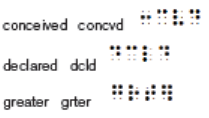
The one may only be used as a group sign when all the three letters it represents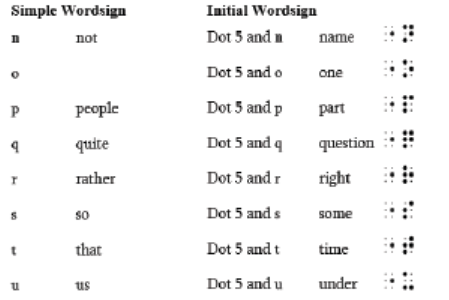
are pronounced as a single syllable, regardless of pronunciation, e.g. done, stones
and gone. One may also be used where a word ends in the letters “oney”.Examples:

The following exceptional words are used where the sign is nevertheless used:
NOTE: When the letters “one” are followed by “d” “n” or “r”, the simple group signs
ed en er must be used.
The part may be used as a group sign where the letters it represents occur
except when followed by the letter “h” in words in which the letters “th” make a
single sound.Examples:
The question and right may generally be used wherever the letters they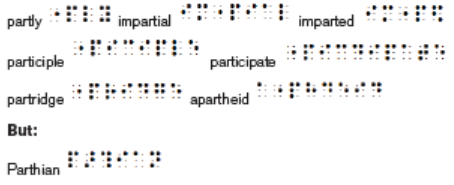
represent occur.Examples:
under may only be used as a group sign where the letters it represents are
pronounced like the word it denotes.
some should be used as a group sign wherever the letters it represents form a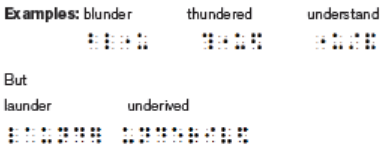
definite syllable of the basic word.

name and time should only be used as group signs when the letters they
represent are pronounced “name” and “time”.Examples:



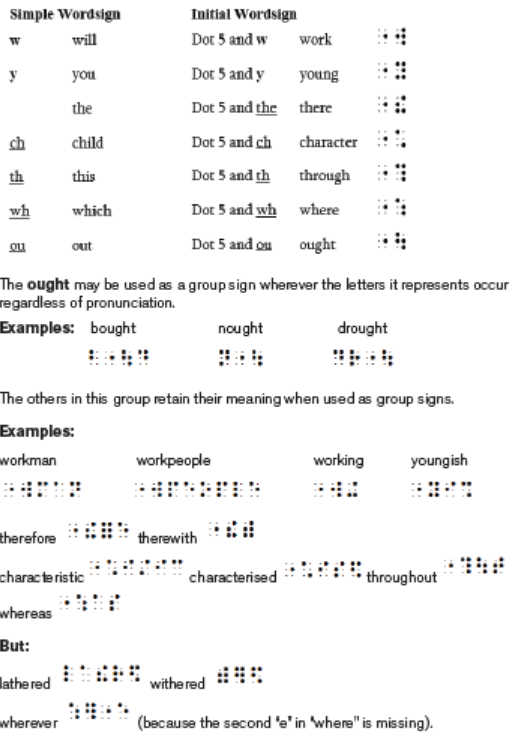
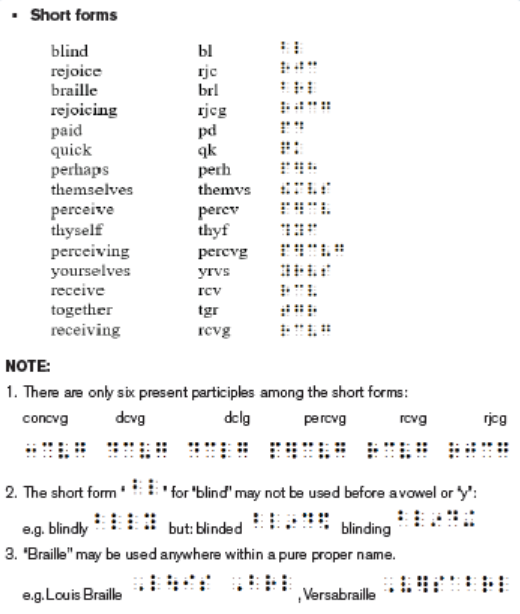
ii) Initial Word signs with two dots: 4 5
The group sign word should be used wherever the letters it represents occur,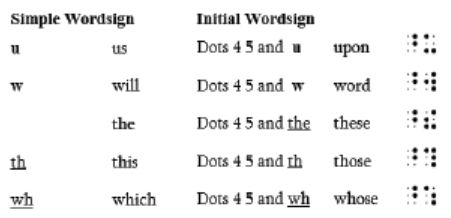
but upon, these, those and whose must retain their meanings as whole
words.Examples:
NOTE: These five can be remembered by the sentence: “upon my word, whose
are these and those?” Therefore, we now have the following:
iii) Initial Word signs with three dots: 4 5 6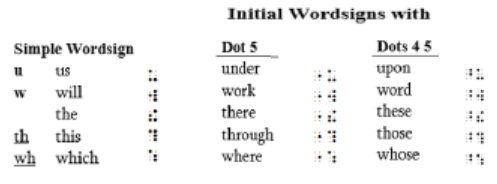
There are six initial signs using all the dots on the right hand side of the firstcell (Dots 4 5 6).
Apart from had, these initial word signs may generally be used as group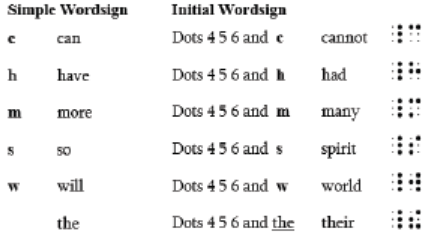
signs wherever the letters they represent occur. The “had” may be used asa group sign when the “a” is short.
These six initial signs may be remembered by the sentence: “Many in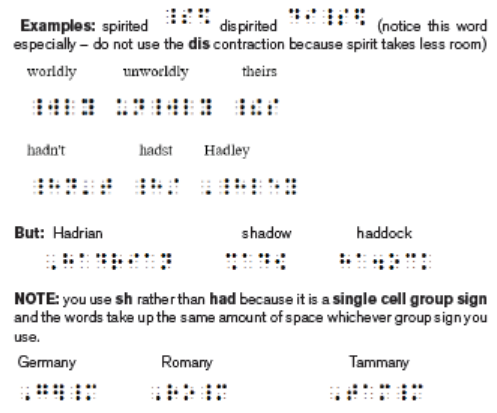
this world cannot have had their spirit”. Therefore, we now have thefollowing:
f) Final Group signs
Final group signs are used to represent certain syllables in words. They consist
of the last letter of the contracted syllable or syllables preceded by one or two
dots-in no case more than two-from the right side of the first cell: either Dots
4 6, or 5 6.
Final group signs are so called because the last letter of the contracted
syllable(s) is used and not, as in the case of initial word signs, the first letter of
the contracted word.
They may only be used as a group sign, for instance, to represent part of a
word, never as a word sign to represent a whole word.
They may not be used after the hyphen in a hyphenated word; as, otherness
(not a frequent case).
They need not be at the end of a word, but they may not be used at the very
beginning of it; where, however, the word is divided at the end of the braille line,
they may, like other group signs, stand at the beginning of the new line.
There are twelve group signs: they will be divided into three groups.
i) First group of final group signs
In this group there are three pairs: in each pair the letter is the same, but the“introductory” dots are different.
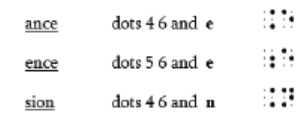
The contraction for ness may be used in feminine endings, except when preceded
by “e” or “i”, in which case the contractions for en or in should be used.
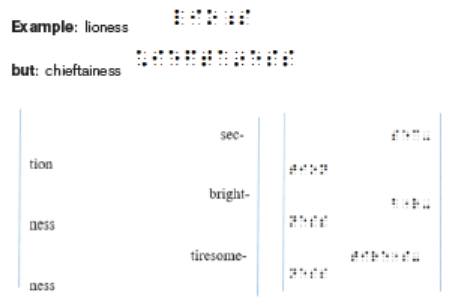
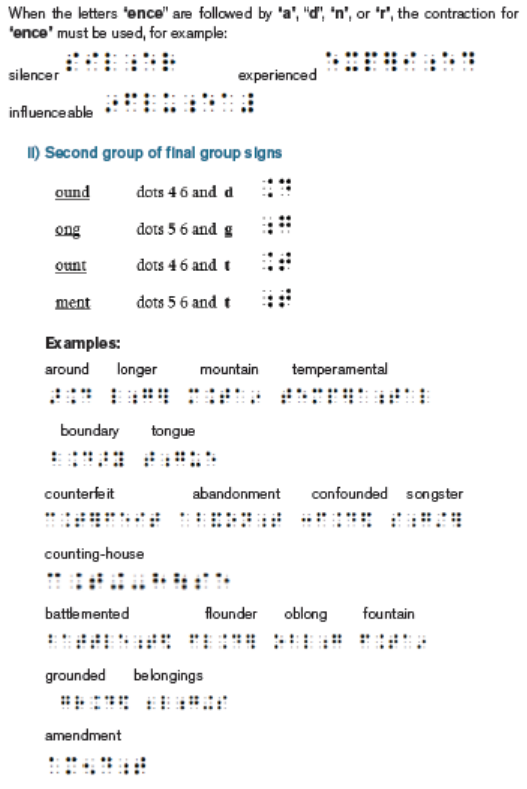
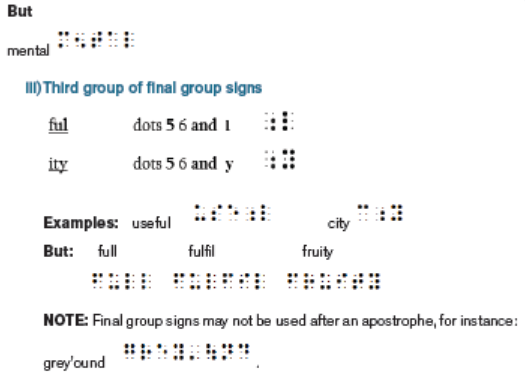
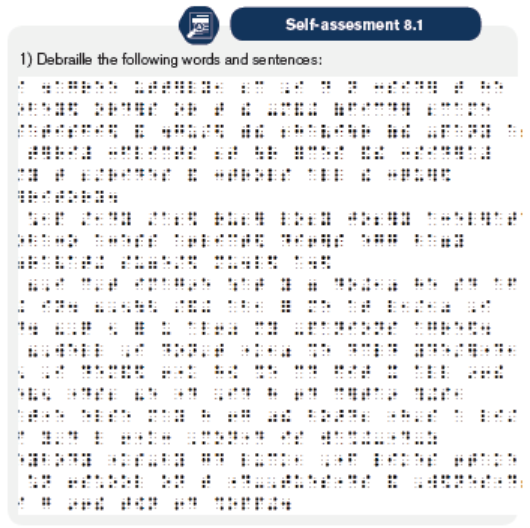
2) Write in Braille the following paragraph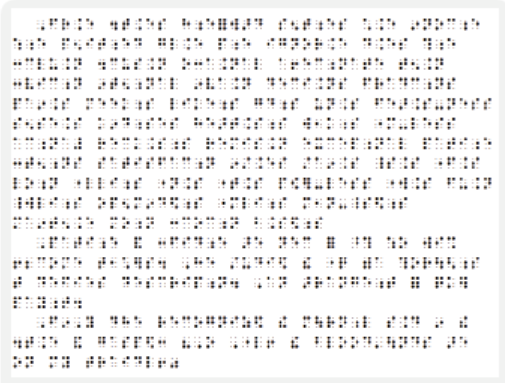
On 2 April 2004 Unified English Braille was agreed by the International
Council on English Braille as sufficiently complete for consideration by
member countries for adoption as their national Braille code. On 14 May 2005
the Australian Braille Authority adopted Unified English Braille as Australia’s
braille code with full implementation envisaged over the next five years. This
primer is a decisive step towards that goal. This May 2006 edition of the
primer represents a work in progress. We are taking a pragmatic approach
to the development of this document, not waiting until all details are finalized,
in order to share information and obtain user feedback. In particular, we have
the inherent flexibility to expand the scope of the primer to cover new topics
considered especially important in the context of Unified English Braille.
We shall take advantage of modern communication technologies to publishregular updates of the primer as deemed appropriate.
8.2. Teaching approaches for learners with visual
difficulties and related techniques (Mobility &
Orientation, sighted guiding, white cane techniques,etc…)
Orientation and mobility is a set of skills that allow for a person who is blind
or has low vision to independently and safely navigate their way through their
environment. Orientation skills enable people with visual impairments to use
sensory information to know their location in different settings, and mobility skills
enable them to travel in different areas. There are a variety of ways people can
travel in the environment. Examples are trailing a wall, using the sighted guide/
human guide technique, using assistive devices like the long cane or a wheelchair,
having a dog guide.
a) Mobility aids
Mobility aids are a huge benefit to many and through orientation and mobility
consultations, people who are blind or have low vision can find the aid that suits
them.
Mobility aids include white canes, Seeing Eye Dogs and monocular – small
devices which magnifies information such as street signs, public transport
route numbers and destination signs on trains, trams and buses.
Newer mobility aids include devices like the Sunu Band, which uses sonar and
vibrations to help people detect obstacles.
An orientation and mobility specialist will work with their client to find the right
mobility aids for them and incorporate them into their training, whether that’s
being guided, locating dropped items or safely navigating their way across a
street or down a busy road.
Orientation refers to a person’s ability to use their senses to know where they
are positioned in their environment. Mobility refers to the person’s capability
and readiness to move in their environment.
b) How to use a white canei) Obtain a suitable cane of the right length for your height
Generally speaking this will mean that the cane grip will reach your armpit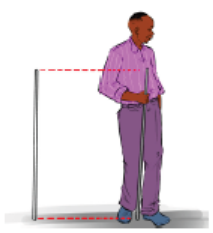
when the tip is resting on the floor.ii) Use the cane with whichever hand feels most comfortable
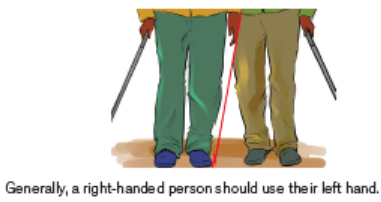
iii) Understand the parts of a cane
Note that all canes consist of 3 main parts; the grip, the tip, and the cane.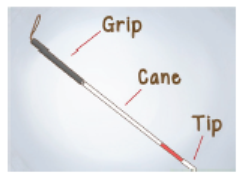
Hold the grip firmly but loosely in your hand. If it has a flat surface, (like agolf club grip) lay your index finger on the flat surface.
iv) Handle the cane
Let your wrist settle to somewhere between your belly button and waist,
slightly to one side, and gently swing the cane from side to side. The tip
should always stay in contact with the ground, swinging approximately thewidth of your shoulders.
v) Know how to walk
When you walk, alternate the swing with your steps. As you step with the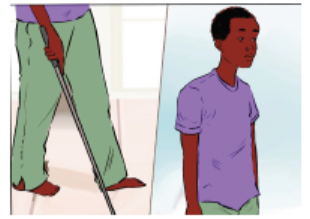
right foot, your cane should go to the left, and vice versa. If you find that your
cane is swinging in the wrong direction, let the cane stay in that general
direction and fix it with your next few steps. Your head should be held high
and your shoulders kept relaxed. This will allow you to use any remainingvision and whatever hearing you have to aid your mobility.
vi) Know how to use the stairs
When going down stairs, let the cane tip fall onto the next step and don’t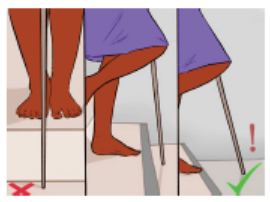
swing it in case other people are trying to go down the stairs too. When
going up the stairs, the cane will hit the first step when you are on the
ground level. Grab the cane so it’s relatively vertical, and let the cane hit
each step as you ascend. Once you reach the top, go back to swinging.
When going down the stairs, let the cane tip fall onto the next step and then
step down to it.
For a smoother descent push the cane forward along the step and allow the
cane drop two steps below, so that it is always a step ahead of you.
• Keep the cane from swinging to allow other people to use the stairs.
• When pushing the cane forward doesn’t result in it dropping you
know you’ve reached the end of that set of stairs. To avoid a nasty fall,
remember that after the cane has reached the bottom of the stairs, youstill have another step to take!
vii) Practice using a cane; it takes a while to get used to
Make sure you are confident in your cane mobility skills before going out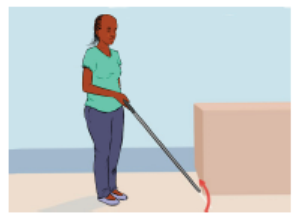
alone.
Note: when training students who do not have visual problems you should
cover their eye with blindfold.
c) Travel tools and techniques of people who are blind or who have
low vision
i) Several choices
People who are blind or visually impaired make choices when it comes to
traveling. At any given time, they can travel using a human guide, which
involves holding onto someone’s arm; using a long, white cane to identify
and avoid obstacles or elevation changes; using a dog guide; using special
optical or electronic aids; or using no additional aid.
The choice of tools depends on the extent and nature of visual impairment,
personal preference, lighting, and familiarity with the area. In order to travel
independently, people with visual impairments use whatever vision they
have, auditory and tactual information, and any gathered knowledge of an
area to keep track of their location and make travel decisions.ii) Human Guide (sometimes referred to as Sighted Guide)
At one time or another, most people who are blind will make use of the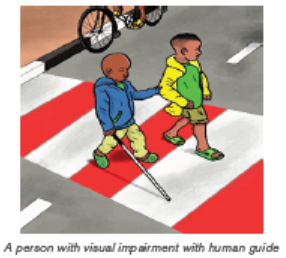
human guide technique, in which a person with sight serves as a guide to aperson who is blind or visually impaired.
iii) Long white cane
Many individuals who are blind or visually impaired use a long white cane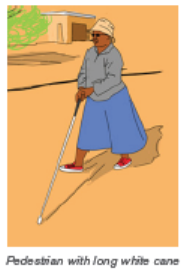
as a mobility device. In the most common technique, the cane is extended
and swung back and forth across their body in rhythm with their steps to
provide information about the environment directly in front of them, such as
elevation changes or obstacles. In another technique often used by people
with low vision, the cane is held diagonally across their body, with the tip
about an inch above the ground. When those individuals are unsure about
what they are seeing, they usually check the object or sidewalk surface with
their cane.iv) Dog guide
Dog guides are carefully trained service animals used as travel tools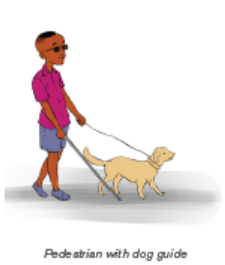
by approximately 2% of people who are blind. The dog responds to the
commands of its handler, such as right, left and forward. The dog guides the
handler around obstacles and stops at curbs or stairs. However, the handler
must know where they are going and make decisions about the proper time
to begin a street crossing. Dog guides move in response to directions from
their handlers but may disobey commands to avoid danger.
v) No aid
Not all persons considered blind use a long white cane or dog guide. People
who are visually impaired often rely on their remaining sight and auditory
and tactile cues in their surroundings for orientation and travel. Some may
also use aids such as telescopes for specific tasks.
vi) Orientation and mobility training
Many pedestrians who are visually impaired or blind have received Orientation
and Mobility training, provided by an Orientation and Mobility (O&M)
Specialist. O&M Specialists usually have an undergraduate or graduate
degree in teaching travel skills to persons who have visual impairments.
Orientation is the ability to understand where one is located in space and
Mobility refers to being able to travel through that space safely. The goal of
most O&M training is to prepare a person who is visually impaired to travel
in a variety of environments, both familiar and unfamiliar, and to assess new
intersections and travel new routes. It is important to note that orientation
training and assistance is not provided for every route that a person who is
blind needs to travel.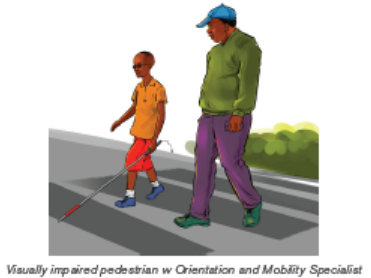
8. 2.4. How people with visual impairment cross streets
a) Traditional techniques
Techniques and cues used in crossing streets are diverse and vary by the type
of location and by the individual and his or her level of vision. Individuals who
are blind or visually impaired often travel to unfamiliar areas and intersections
and gather information from available sources in order to do so safely.
The discussion of techniques below describes typical techniques used at
unfamiliar intersections, although most travel by pedestrians who are blind
is probably on routes with which they are familiar. However, it is also not
uncommon for bus drivers or taxi drivers to provide incorrect information about
the location or drop off a person at a slightly different location than expected,
so it is necessary to regularly confirm information using nonvisual techniques
described below.
Once pedestrians who are blind are familiar with an intersection, they do not
usually need to analyze the intersection and traffic control system at length
every time. However, they still may need to listen long enough to determine
that they are at the correct location and that the signal is functioning as usual.
Pedestrians who are blind will still need to detect the street, align to cross,
identify the walk interval, and maintain alignment while crossing. APS can
particularly assist with the task of identifying the walk interval at familiar and
unfamiliar locations.
b) Detecting the street
The first information needed by pedestrians who are blind is “Have I arrived at
a street?” People who are blind or visually impaired use a combination of cues
to recognize the street edge. These may include:
• Curb or the slope of the ramp
• Truncated dome detectable warnings, if available
• End of building line and open sound of the intersection
• Sound of traffic on the street beside them (the parallel street)
• Sound of traffic stopping on the street they are approaching (the
perpendicular street)
• Presence of pedestrians
• Presence of an intersecting sidewalk
c) Identifying the street
The next information needed for decision-making at unfamiliar intersections is:
“Which street is this?”
• This information is only occasionally provided in any accessible format.
• Pedestrians who are visually impaired develop a mental map and keep track
of where they are within that map, usually by counting blocks and street
crossings.
• Where necessary, and available, assistance may be sought from other
pedestrians.
d) Analysing intersection geometry
The next information needed is: “What is the geometry of this intersection?”
including:
• Is my destination curb straight in front of me, or must I angle to the left or
right to reach it?
• How many streets intersect here?
• How wide is this street?
• Should I expect to encounter any islands or medians as I cross this street?
• Am I standing within the crosswalk?
This information may be immediately available to pedestrians having full vision,
but it may not be possible for pedestrians who are blind to determine this
information by listening to traffic patterns. Incorrect or missing information for
any of these questions may result in missing the destination curb or median.
e) Analysing the traffic control system
Next, pedestrians with visual impairments need to know: “What is the type of
traffic control system at this intersection:
• Is this a signalized intersection?
• Do I need to push a button to actuate the walk interval? If so, where is the
button?
• Is the button close enough to the crosswalk that I will have time to push
the button, position myself correctly at the crosswalk, and re-establish my
alignment facing the destination curb before the onset of the walk interval?
• Which button controls the walk interval for the street I want to cross?
• Does it stop traffic on one street, or all traffic?
• Do cars still turn during the walk interval?
• Is there a second button on the median or crossing island that I must push?
• Will there be a surge of parallel traffic telling me the walk interval has begun?
Will I be able to hear it over other, concurrent traffic sounds?
Techniques for gathering this information include listening to traffic patterns
through several signal cycles and searching the sidewalk area for poles with
pushbuttons. Missing information for any of these questions may result in
failure to use pedestrian pushbuttons, not beginning the crossing during the
walk interval, not completing the crossing before perpendicular traffic begins
moving, and crossing at times other than the pedestrian phase.
f) Aligning to cross
Before starting to cross, the pedestrian must align to cross or choose a
heading for the crossing. Typical techniques for this task include maintaining
the alignment used on the approach to the intersection and listening to parallel
traffic through a signal cycle to confirm alignment to parallel traffic. The need
to use pedestrian pushbuttons often prevents the use of parallel traffic for
alignment. After pushing the button, the pedestrian must cross on the next
pedestrian phase, which is usually the next time that traffic begins moving
parallel to the pedestrian’s crosswalk.
g) Identifying the walk interval
After determining the geometry of the intersection, aligning to face towards
the destination curb, determining that the intersection is signalized and having
pushed a button, where necessary, pedestrians who are blind need to know:
“When does the walk interval begin?”
In the most common technique utilized for crossing at signalized intersections,
pedestrians who are blind or visually impaired begin to cross the street when
there is a surge of traffic on the street parallel to their direction of travel. This
technique is dependent upon the presence of traffic and consistent signal
phasing. Various types of phasing and intermittent or low volumes of traffic
traveling parallel to the pedestrian may affect the reliability of that technique.
h) Maintaining crossing alignment
Once the pedestrian who is blind has begun to cross the street, the next
question is: “Am I headed straight towards my destination curb?”
• Traffic going in the same direction on the parallel street provides helpful
auditory guidance to many persons if it is present. In addition, pedestrians
who are blind may use traffic waiting on the perpendicular street as a partial
alignment cue.
• Turning traffic can make it difficult to hear and align with the traffic traveling
straight through the intersection.
In the absence of traffic on the parallel street, pedestrians who are blind are
more likely to veer toward or away from the intersection.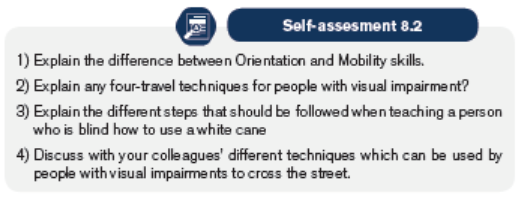


BIBLIOGRAPHY
– Braille Authority of North America (1994). English Braille American Edition.
American Printing House the Blind.
– Braille Authority of the United Kingdom (2004). British Braille: A Restatement
of Standard English Braille Compiled and Authorized. Royal National Institute
of the Blind Bakewell Road, Orton Southgate Peterborough, Cambridgeshire
– Brown, S. Rust, C. & Gibbs, G. (1994). Strategies for Diversifying Assessment
in Higher Education. The Oxford Centre for Staff Development, Oxford.
Oxonion Rewley Press.
– Brown, G., Bull, J. & Pendlebury, M. (1997). Assessing Learner Learning in
Higher Education, Routledge, London.
– Cowan, J. (2005). In: Designing assessment to enhance learner learning.
– Florian, L & Linklater, H. (2010). Preparing Teachers for Inclusive Education:
Using Inclusive Pedagogy to Enhance Teaching and learning for All.
Cambridge Journal of Education, 40(4), 369-386. Doi: 10.1080/0305764X.
2010.526588 .
– Howard G. (2010). Multiple intelligences. http://www.howardgardner.com/
MI/mi.htm
– Hughes, I E. (1995). Peer assessment of learner practical reports and its
influence on learning and skill acquisition. Capability. 1, 39-43.
– Howse, J., Kathy, R., and Leona, H. (2013). Unified English Braille. Australian
Training Manual. Australia: Round Table on Information Access for People
with Print Disabilities
– Howse, J. (2006). Unified English Braille Primer. Australia. The NSW
Department of Education and Training Publisher.
– Skinner, M. (2008). The School Counselor, Vol.33, No.2
– Karangwa, E. (2008). Initiation a l’Education Speciale et Inclusive. Manuel
de formation pour les Enseignants au Rwanda, Kigali.
– Linklater, H. (2013). Teaching and the individuality of everybody FORUM
51(5).
– Pantic, N & Florian, L. (2015). Developing teachers as agents of inclusion
and social justice. Education Inquiry 9Edu. Inq.) 6(3), 333-351 & nbsp.
– Padden. (1992). Learning Sign Language. Englewood: Prentice hall.
– Race, P. Brown, S. and Smith, B. (2005). 500 Tips on assessment: 2nd
edition, London: Routledge.
– Ramsden, P. (1988). Improving Learning: New Perspectives. London. Kogan
Page.
– Thomas, P. (2003). Inclusive Education Training in Cambodia: In-service
teacher training on Disability and special needs issues, Disability Action
Council Cambodia, published by EENET.
– United Kingdom Association for Accessible Formats (2013). Unified English
Braille (UEB). Summary of changes for ordinary braille.
– UNESCO Bangkok. (2004). Embracing Diversity: Toolkit for creating
inclusive learning Friendly environments, UNESCO Bangkok.
– UNESCO Bangkok. (2004). Creating Inclusive Learning-Friendly
Classrooms, Booklet 4 from the ‘Embracing Diversity’ toolkit, UNESCO
Bangkok.
– William, N; Stinson, M., Castle, D.; Mallery, R.; Holcomb. B. (2013). RwandanSign Language Dictionary. First edition.
